ANCIENT COINS
It is accepted that the first true coins (metallic disks of a certain fineness and weight with indicators of source) were issued around 650BC. The earliest coins usually had a rather primitive animal or human figure on the obverse with a punch (geometric or otherwise) on the reverse. They were originally struck in electrum, a natural alloy of silver and gold. When the ancients developed the technology to isolate the metals, they struck coins in gold and silver, as well as bronze. As time progressed, imagery was placed on both sides of the coin.
By the next century the coinage really blossomed, in quality as well as number of varieties. Over 1,000 individual Greek city-states issued coinage during ancient times. After the defeat by Rome, many of these cities still minted coins but with Roman emperors on them.
Roman coinage started in the Republic and ran until the capital was moved from Rome to Constanopolis. After Caesar, every emperor issued coins depicting themselves, their wives, their childran, and their parents. The reverses usually pictured one of their gods or goddesses. They issued many commemorative reverses to celebrate victories as well as other important events. Many of these depict structures that still exist today. Roman coins were minted in all areas that they occupied and were mint marked by standard annotations so you know where the coin was actually minted. .
Coins were hand struck in those days, leading to off center strikes and rotated reverses on some. The dies were hand cut by artisans known as celators who engraved the coin designs into bronze dies.. They created two dies, the anvil die (usually the obverse) and the hammer die (usually the reverse die). The coin planchets were usually heated to soften them before they were struck. The hammer die was struck by a mallet handled by a strong man.
This is a grouping of ancient coins to acquaint you with this often forgotten part of human history. I will start with the oldest progressing through to the newest. The "newest" is still mighty old!
Thanks to Wikipedia for much of the historical background information.
This page is divided into three major sections:
GREEK Click Here
ROMAN Click Here
ROMAN-GREEK PROVINCIAL Click Here
Greek
The Greeks were true artisans and some of their coins are unparalled even today in the artistic design and engraving of coinage. Most of the Greek issues included reference to the issuing authority, the magistrate responsible, and, in some cases, even the name of the artisan that designed the coin.
Greek silver coinage were minted in several denominations: dekadrachm (10 drachmas), tetradrachm (4 drachmas), didrachm (2 drachmas), drachm, tetrobol (4 obols), hemidrachm (half drachma - 3 obols), diobol (2 obols), obol, and even smaller fractional denominations. Ther dekadrachm pieces are exceptionally rare and expensive. The tetradrachms and drachmas are the most common.
The standard silver coinage was the drachma (about the size of a U.S. dime) which was 4.3 grams of silver and the tetradrachm (four drachmas about the size of a U.S.. half dollar) which was 17.2 grams of silver. Both of these are relatively commonly found today. Most of the Greek coins were of the Attic Standard.
Greece per se did not exist in those days. What we today call Greece was then over 2,000 individual independent or semi-independent city-states, at least half of which issued their own coinage. Most of these city-states were constantly at war either with each other or with foreign invaders such as the Persians. Alexander the Great of Macedonia forcibly united the Greeks and launched an empire that ultimately reached as far as Egypt in the south and India in the east. He established mints in all these territories that struck his coinage. His coinage has a plethora of mintmarks and, in some cases, symbols for magistrates responsible for the coinage. These mintmarks can be images of animals, ships, decorations and monograms of various letters. Most of these have been attributed by hoards found in areas of his former occupation.
Many of the cities issued coins that bore the image of their patron god or goddess or a legendary hero (such as Hercules) on the obverse and a symbol of the city on the reverse. An example is Rhodes that used a rose as the Greek word for rose is ρόδον. Gradually, some of the cities started using their name or abbreviations of same on the reverse side.
Greek cities of Sicily designed and minted some of the most beautiful coins ever seen including today. The large silver dekadrachm coin from Syracuse is an example. The obverse features the goddess Arethusa and the the reverse has a charioteer driving a quadriga with Nike flying overhead with a victory wreath. This image was also used on the tetradrachm, a single example of which is shown from my collection. Some of these coins have the name of the artist that designed the coins.
As the Greek epoch faded, the Romans took over. The quality of the coinage, artistic as well as, ultimately, the purity of the metal, deteriorated. In the time of the Roman Republic through about 300 AD, the coins are still pleasing. After the fall of Greece, many formerly Grecian territories and cities continued issuing coins under the Roans. These coins are commonly referred to as Roman Provincial or Greek Imperial coinage and these issues are included in the third section. Later into the Byzantine epoch the designs' quality deteriorated and became primitive again.
The common reference series on these coins:
-
GREEK COINS AND THEIR VALUES by David L. Sear by Seaby Publications London (a two volume set)
-
THE COINAGE IN THE NAME OF ALEXANDER THE GREAT AND PHILIP ARRHIDAEUS by Martin Jessop Price by the British Museum (a two volume set)
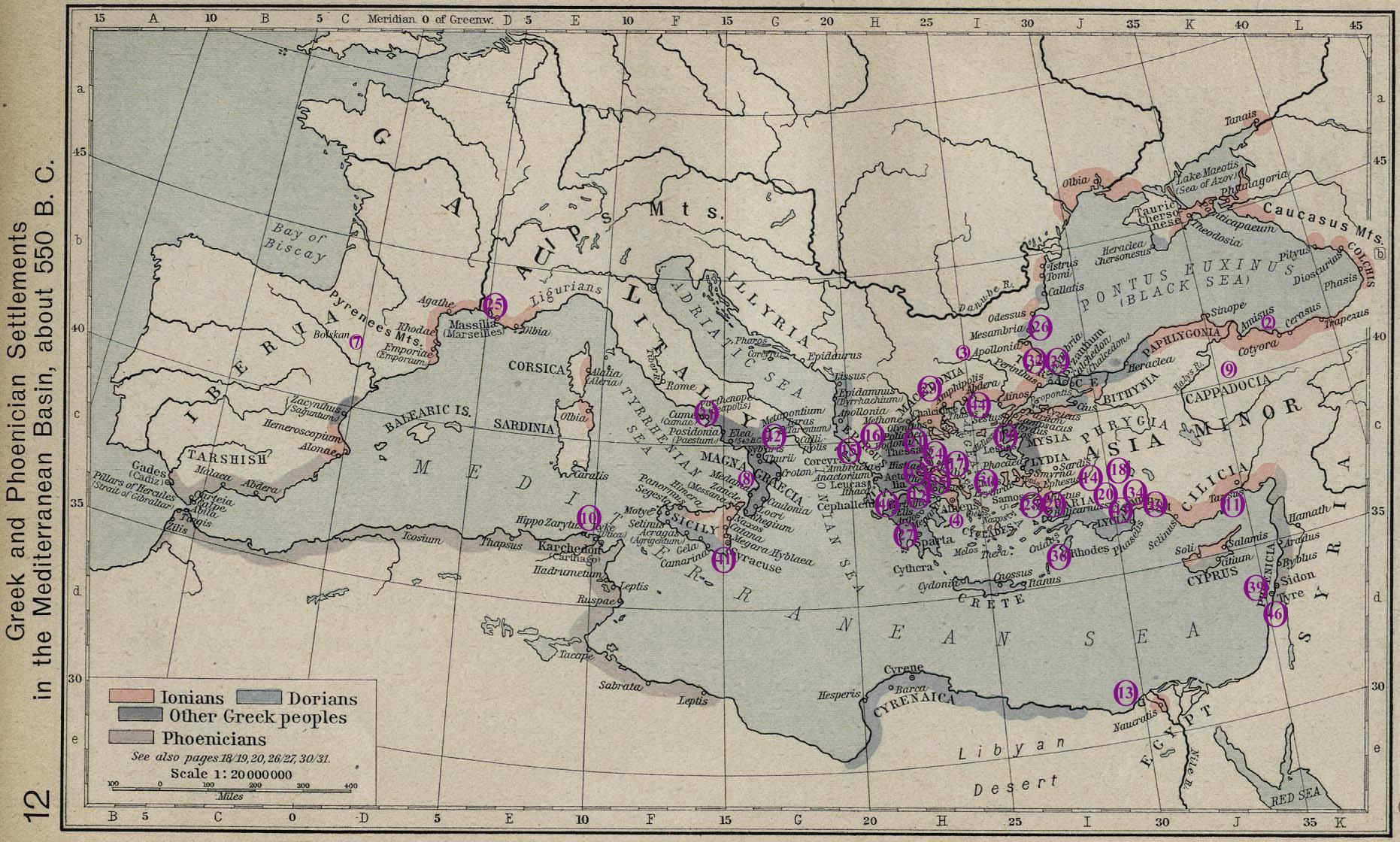
If you want to look at a particular coin location (the numbers refer to the map above):
1. ABBAITIS Click Here
2. AMISOS Click Here
3. APOLLONIA Pontika Click Here
4. ATHENS Click Here
5. BABYLON Click Here
6. BACTRIA Click Here
7. BOLSKAN, IBERIA Click Here
BELIKIOM Click Here
8. BRUTTIUM Click Here
9. CAPPADOCIA Click Here
10. CARTHAGE Click Here
CASTULO Click Here
11. CILICIA Click Here
12. CORINTH Click Here
13. EGYPT Click Here
14. EPHESUS Click Here
15. EPIDAMNOS-DYRRHACHIUM Click Here
16. EPIRUS Click Here
17. EUBOIA Click Here
18. EUMENEIA Click Here
19. KOLONE Click Here
KROTON Click Here
20. LAODIKEIA Click Here
21. LARISSA Click Here
22. LYSIMACHOS Click Here
23. MACEDONIA Click Here
24. MAGNESIA Click Here
25. MASSILIA, GAUL Click Here
26. MESEMBRIA Click Here
27. MESSENE Click Here
28. MILETOS Click Here
29. MYNDOS Click Here
30. MYRINA Click Here
31. NEAPOLIS Click Here
ODESSOS Click Here
32. PAEONIA Click Here
33. PARTHIA Click Here
34. PERGE Click Here
35. PHARSALOS Click Here
36. RHODES Click Here
37. SELEUKID KINGDOM Click Here
38. SIDE Click Here
39. SIDON Click Here
40. SIKYON Click Here
41. SYRACUSE Click Here
42. TARENTUM Click Here
43. TERMESSOS MAJOR Click Here
44. THASOS Click Here
45. THESSALIAN LEAGUE Click Here
46. TYRE Click Here
MILETOS, IONIA ca 525BC
MILETOS was an ancient Greek city on the western coast of Anatolia, near the mouth of the Maeander River in ancient Caria. Its ruins are located near the modern town of Balat in Aydin Province, Turkey. Before the Persian invasion in the middle of the 6th century BC, Miletus was considered the greatest and wealthiest of Greek cities. Evidence of first settlement at the site has been made inaccessible by the rise of sea level and deposition of sediments from the Meander. The first available evidence is of the Neolithic Age. In the early and middle Bronze Age the settlement came under Minoan influence. Legend has it that an influx of Cretans occurred displacing the indigenous Leleges. The site was renamed Miletus after a place in Crete.
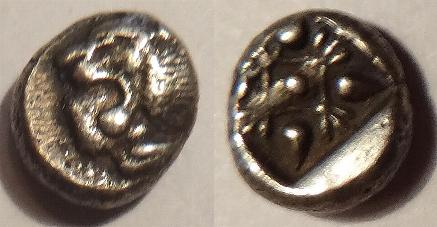
This tiny silver coin is a hemiobol (1/12 drachm) isued in Miletos around 525BC. It is of the earliest coin design, a figure of a roaring lion''s head on the obverse and a geometric star shaped punch on the reverse. The coin measures 8mm.
ATHENS - ca450BC
ATHENS is one of the oldest named cities in the world, having been continuously inhabited for at least 7000 years. Situated in southern Europe, Athens became the leading city of ancient Greece in the first millennium BC and its cultural achievements during the 5th century BC laid the foundations of western civilization. The etiological myth explaining how Athens acquired this name is the legendary contest between Poseidon and Athena which was described by ancient Greek scholars. Both Athena and Poseidon wanted to be patrons of the city and to give their name to it, so they competed with each other for the honor, offering the city one gift each. Poseidon produced a spring by striking the ground with his trident, symbolizing naval power. Athena created the olive tree, symbolizing peace and prosperity. The Athenians, under their ruler Cecrops, accepted the olive tree and named the city after Athena.
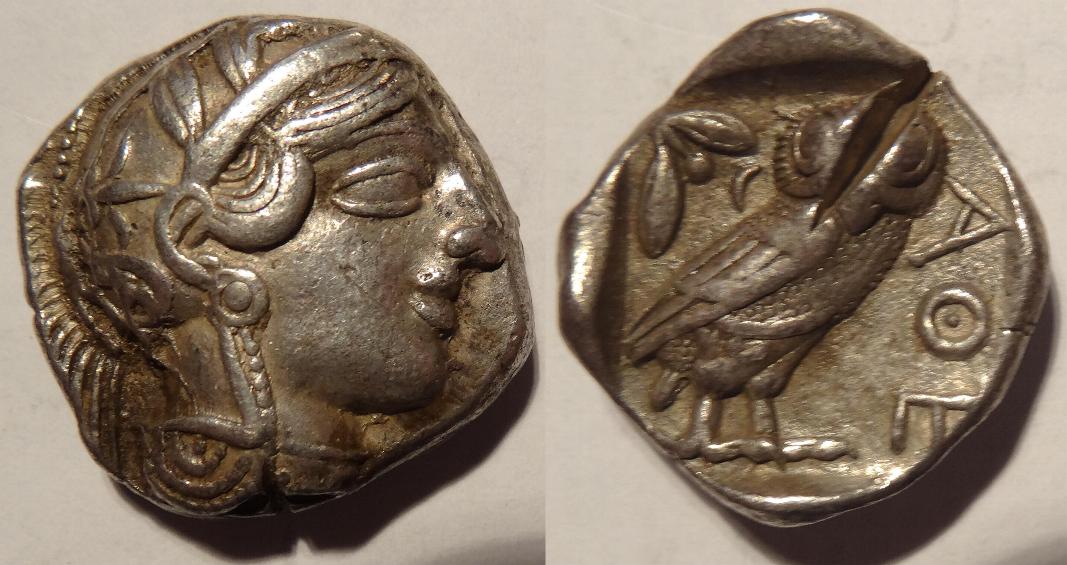
This coin is one of the earliest versions (called "old style") of the Athens tetradrachm. This type was minted from 447 to 413BC at the Acropolis. The coin measures 23mm and weighs 17 grams. The obverse has the head of the patron goddess Athena. The reverse has the Athenian owl with an olive sprig and a crescent moon to the left and the Greek letters ΑΘΕ for Athens. The coin has a banker's cut on the reverse to verify the coin being silver, many of these coins are found cut.
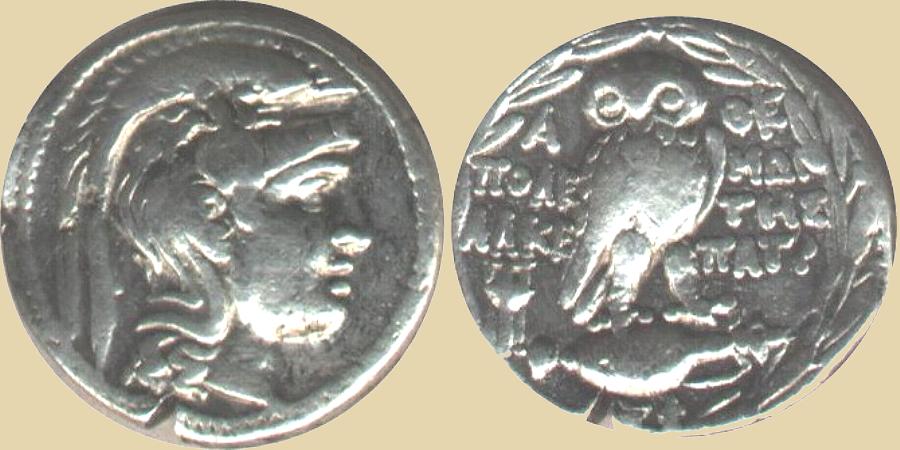
This coin is one of the last of the types ("new style"). This type was minted around 125BC. The obverse has Athena Parthenos in a triple crested helmet. The reverse has the Athenian Owl standing on an amorpha with a tripod to the left and ΣΦ in the exeurge. The legend ΑΘΕ ΠΟΛΕ-ΜΩΝ AΛΚΕ- ΤΗΣ -ΡΑΤΡ. These coins were issued by various magistrates and this identifier indicates that Polemon, Alketes and Patro were the magistrates. The coin measures 30mm and weighs 17 grams.
.
SYRACUSE ca 450BC
The city was founded by ancient Greek Corinthians and Teneans over 2700 years ago and became a very powerful city-state. Syracuse was allied with Sparta and Corinth, exerting influence over the entire Magna Graecia area of which it was the most important city. Once described by Cicero as "the greatest Greek city and the most beautiful of them all", it later became part of the Roman Republic. After the great victory over the Carthaginian invaders at Himera in 480 BC, Syracuse rose to a position of pre-eminence among the Sicilian Greeks. She maintained that position throughout the 5th century BC, although her power was much curtailed at the close of that century when the Carthaginians finally gained a firm footing on the island. The 4th century BC was a troubled time for the island, even though there were valiant efforts by the Greeks to reestablish their control over the whole island. The Carthaginians were defeated by the Romans in the First Punic War, and the victors took possession of the whole of Sicily. As a Roman ally, Syracuse was allowed to retain its independence
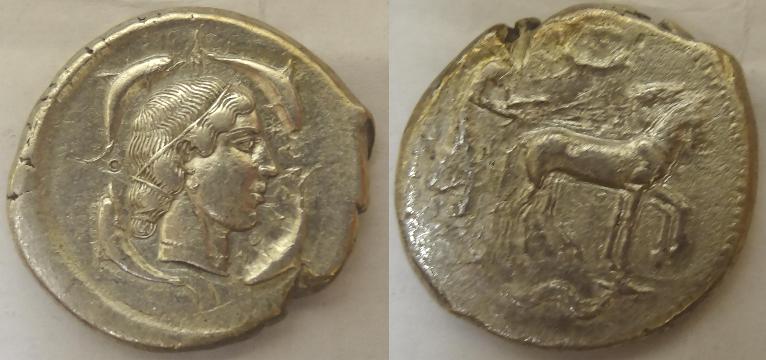
This is a silver tetradrachm from Syracuse in Sicily, minted from 450-440BC. The obverse has the head of Artemis-Arethusa facing right surrounded by four dolphins. The Greek legend SURAKOSION is to the right of her face. The reverse has a quadriga driven to the right by a male charioteer, with Nike, the god of victory, flying above, crowning the horses with a wreath. There is ketos (sea monster) in the exergue.
APOLLONIA Pontika ca450BC
Apollinia Pontika is one of the oldest towns on Bulgarian Thrace's Black Sea coast. The first settlement on the site dates back to the Bronze Age. Undersea explorations in the region of the port reveal relics of dwellings, ceramic pottery, stone and bone tools from that era. Many anchors from the second and first millennium BC have been discovered in the town's bay, a proof of active shipping since ancient times. The current town was founded in the 7th century BC by Greek colonists from Miletos then named Antheia. The name was soon changed to Apollonia, on account of a temple dedicated to Apollo in the town, containing a famous colossal statue of the god by Calamis, 30 cubits (fifty feet) high, transported later to Rome by Lucillus and placed in the Capitol. The symbol of the town, the anchor, is present on all coins minted by Apollonia since the sixth century BC. It is proof of the importance of its maritime trade.
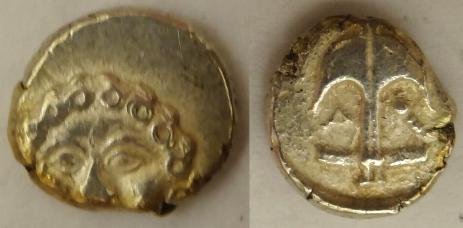
This silver drachm was minted about 450BC. The obverse has an image of an upside down anchor with the letter A on the left and a crayfish on the right of the anchor's shank. The reverse has a depiction of a Gorgoneion (a special apotropaic amulet showing the Gorgon head). The reverse was struck off center.The coin measures 13mm and weighs about 3 grams.
PHARSALOS ca 440BC
PHARSALOS is a city in southern Thessaly, in Greece. The Pharsalos of the historic era was built over a hillside of the Narthacius mountains at an elevation of some 500 feet, where modern Farsala stands. It was one of the main cities in Thessaly and was the capital of the Phthian tetrarch. In the Persian Wars they sided with the Athenians. A distinctive tribe of the city was that of Echecratidon. In the early 4th century BC, the city was a part of the Thessalian Commons. Later, it joined the Macedonian Kingdom under Philip II, father of Alexander the Great. The area became a theater of war where the Aetolians and the Thessalians clashed with the Macedonians, especially during the Second and the Third Macedonian Wars. After the defeat of the Macedonian Kingdom, Pharsalos and the whole area became a part of the Roman Republic.
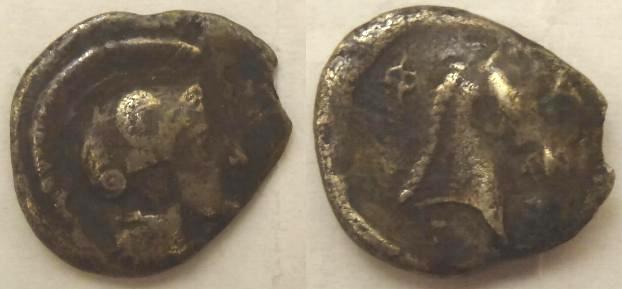
This is silver hemidrachma (half drachm) issued in 440-344BC. The coin measures 14mm. The obverse has a bust of Athena in crested Attic helmet facing right. The reverse has a horse head facing right with ΦΑΡΣ around the head.
BABYLON, MESOPOTAMIA ca 411BC
BABYLON was founded about 2300BC in Mesopotamia. It became independent in 1894BC. It was ruled by various semitic groups at varying times. The city was destroyed, then rebuilt by the Assyrians. Persia captured it in in 549 BC until overthrown by the Greek forces under Alexander the Great in 331BC. Alexander died in Babylon in 323BC. Babylon declined in importance after Alexander's death.
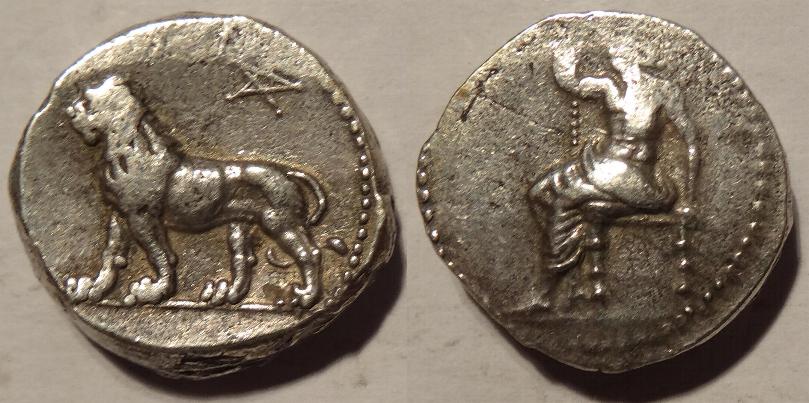
This coin is a silver tetradrachm issued about 411BC . It measues only 23mm in diameter but is about 4mm thick. It weighs about 17 grams. The obverse pictures a lion with a 5 pointed star above. The reverse has the image of the god Baal sitting facing left.
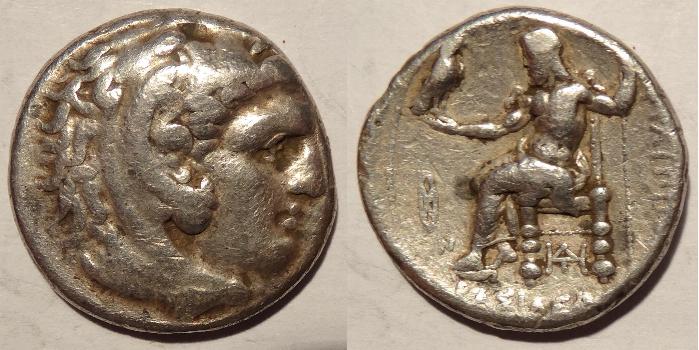
This coin is a tetradrachm issued in the name of Philip III, half brother of Alexander the Great, about 323BC. It was minted from Alexander's death in Babylon to about 316BC. It measures 26mm and weighs 17 grams. The obverse has the head of Herakles wearing a lion scalp and facing right. The reverse has Zeus enthroned left, holding an eagle in right hand; with a monogram under the throne, To the right is ΦΙΛΛΙΠΟΥ, ΒΑΣΙΛΕΩΣ is in the exergue. There are two monograms to the left of Philip's knees, one being an ear of corn and the other a character similar to N.
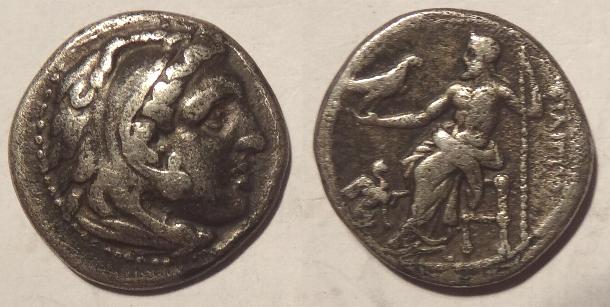
This coin is a drachma issued in the name of Philip III, half brother of Alexander the Great, about 323BC. It was minted from Alexander's death in Babylon to about 316BC. It measures 17mm and weighs 4 grams. The obverse has the head of Herakles wearing a lion scalp and facing right. The reverse has Zeus enthroned left, holding an eagle in right hand and a staff in his left. To the right is ΦΙΛΛΙΠΟΥ. There is a monogram of a griffen to the left of Philip's knees.
KROTON ca 400BC
Kroton was founded around 710 BC as an Achaean colony on the southeast coast of Italy. It is known today as Crotone, Italy.
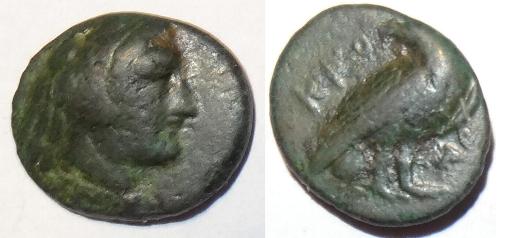
This small bronze coin was issued around 400BC. The obverse features the head of Herakles facing right. / KRO-T, The reverse has an eagle standing facing right with his head turned back with legend KRO-T,. The coin measures 14mm.
MESSENE, PelopOnnesia - ca 369BC
MESSENE was a city in the Peloponnesian area of Greece. It was founded by the general Epaminondas in 369BC.
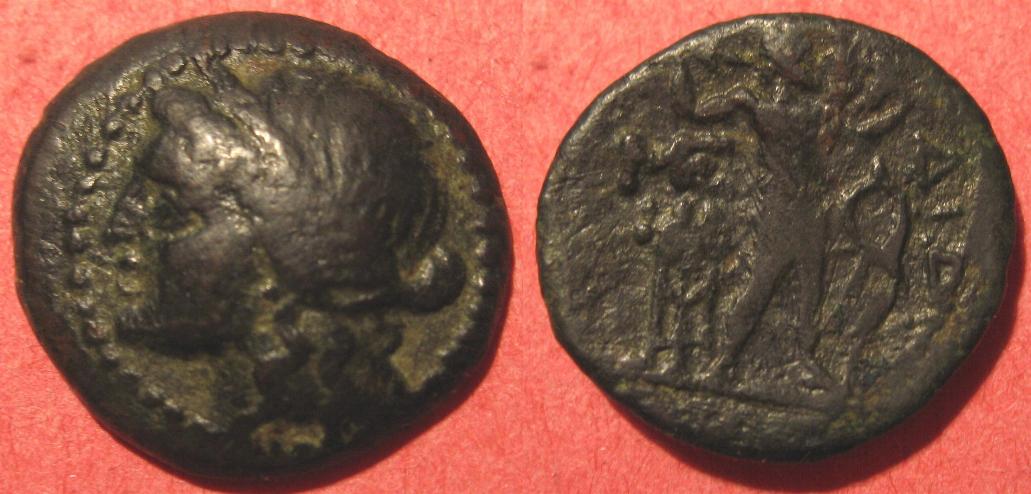
This bronze coin measures 22mm and weighs about 6.5 grams. It was minted from 369-280BC. The obverse has the diadimed head of Demeter, goddess of the harvest, facing left.The reverse has Zeus Ithomates standing to the right throwing a thunderbolt with a tripod to the left and a round object to the right. Monogram ME is to the left and ΔΙΩΝ to the right.
It is located in the Thessaly region of Greece. According to Greek mythology it is said that the city was founded by Acrisius, who was killed accidentally by his grandson, Perseus. There lived Peleus, the hero beloved by the gods, and his son Achilles. In mythology, the nymph Larissa was either a daughter or mother of the primordial man Pelasgus.
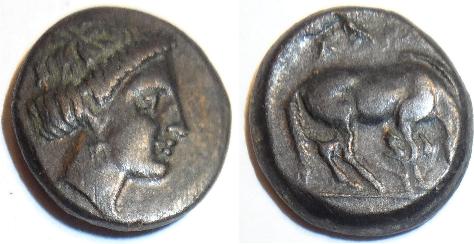
This bronze coin was minted around 360-325BC. The obverse has the head of nymph, a divine spirit who animates nature usually depicted as a cbeautiful, young nubile maiden who loves to dance and sing, Larissa with hair rolled facing right. The reverse has a horse grazing right, left forefoot raised. Has the Greek legend LARISAIWN. The coin measures 17mm.
Sikyon, PelopOnnesia ca 350BC
SIKYON is an ancient city northwest of Corinth on the Peloponnesian Penisula. It is believed it was established around 2000BC by Dorians. It remained under their control until about 700BC when it more or less became independent. It lost it around 600BC and became part of the Peloponnesian League. During the Peloponnesian Wars, it sided with Sparta and Corinth and later in the Corinthian War, it remained loyal to Sparta. The city 's importance was later overshadowed by Corinth and Patras.
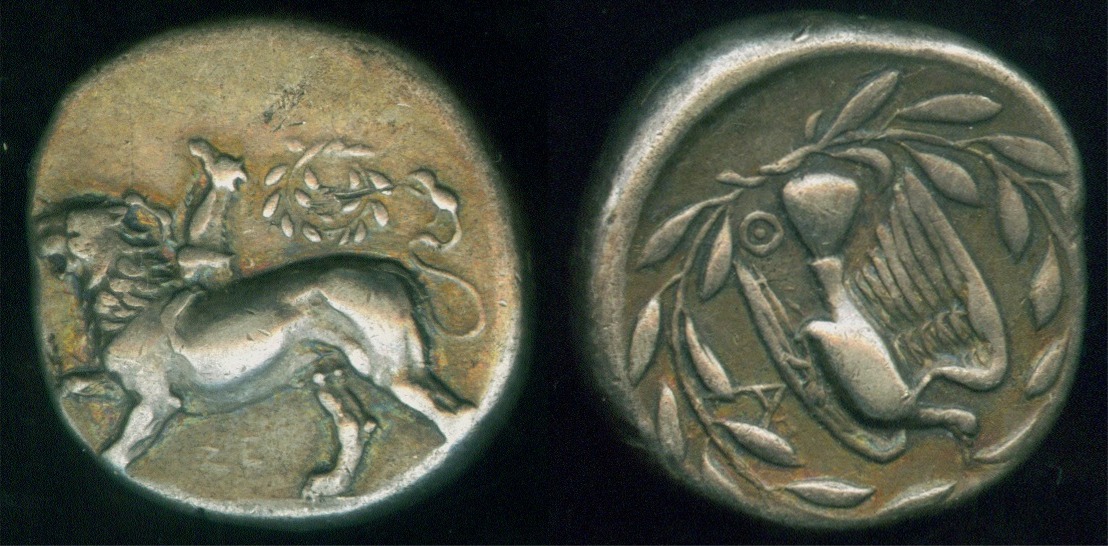
This coin is a silver stater. It measures 22mm and weighs 12 grams. It is thought that it was issued around 350-329BC. The obverse pictures a chimera with a wreath above and the Greek letters ΣΕ, The chimera was a mythical monstrous fire-breathing creature composed of the parts of three animals — a lion, a snake and a goat. Usually depicted as a lion, with the head of a goat arising from its back, and a tail that ended in a snake's head. The reverse pictures a dove flying to the right within a wreath. The Greek letter Θ under the tail and A under the lower wing. There are many variants of this design, some with the chimera facing right, and most with the dove flying to the left. The dove is sometimes without the encircling wreath.
CORINTH ca 350BC
CORINTH was occupied from at least as early as 6500 BC. Dorians settled there around 900BC. In 733 BC, Corinth established colonies at Corcyra (modern Corfu) and Syracuse. By 730 BC, Corinth emerged as a highly advanced Greek city. Corinth rivaled Athens and Thebes in wealth.
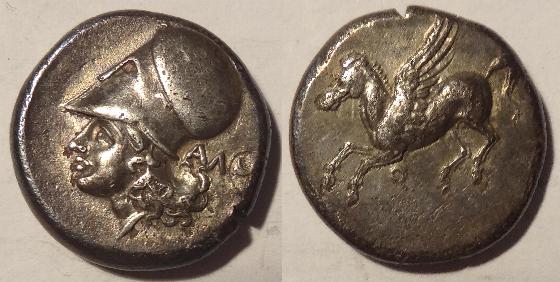
This is a silver stater from Corinth issued 350-307BC. The obverse has Pegasus flying left, with koppa (an archaic Greek letter often signifying a number) below. The reverse has the head ead of Athena facing left in a Corinthian helmet with the Greek letters ΑΛ behind the neck. There is a partial image to the right but most is off the planchet. The coin measures 20mm and weighs 8.5 grams.
NEAPOLIS ca 350BC
NEAPOLIS was the Greek colony now known at Naples in Italy. Naples is one of the oldest continuously inhabited cities in the world. Bronze Age Greek settlements were established in the Naples area in the second millennium BC. The city was refounded as Neápolis in the sixth century BC and became a lynchpin of Magna Graecia, playing a key role in the merging of Greek culture into Roman society
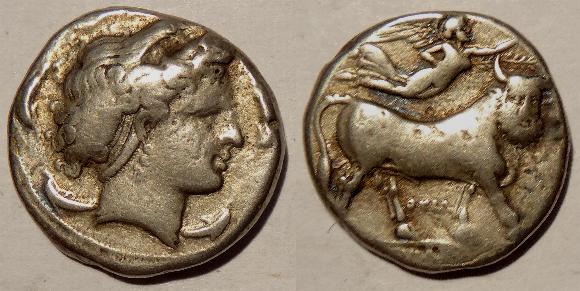
This silver coin is a didrachm (two drachma piece). It was minted about 350 BC, The obverse has the head of Nymph facing right, with dolphins around. The reverse has a man-headed bull standing facing right, with Nike flying above. The coin measures 21mm and weighs 6.5 grams.
KOLONE, TROAS ca 350BC'
A small town on the western border of Troas, just south of Alexandreia Troas. Troas gets its name from the Hittites' name for the region, Taruisa. Hellenistic settlements flourished in Troas during Archaic and Classical Ages
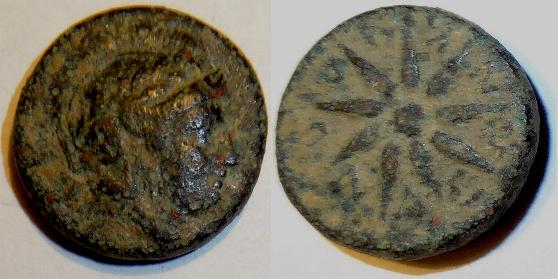
This bronze coin was minted around 350-310BC. The obverse has a laurate head of Athena facing right wearing an Attic helmet The reverse has a nine-rayed star with inscription K-O-Λ-O-N-A-Ω-N between rays. The coin measures 17mm.
PARION, MYSIA - 350-300BC
Parion was a Greek city of Adrasteia in Mysia on the Hellespont.
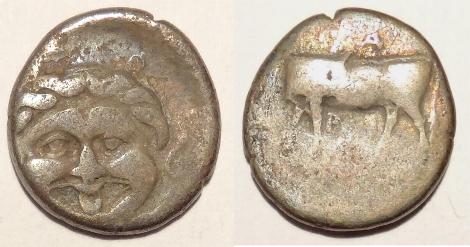
This silver hemidrachm was minted around 350-300BC. The obverse has a Gorgoneion head facing. The reverse has a bull standing left, looking back with a monogramabove and; P I and vine-leaf below. The coin measures 14mm.
PAEONIA ca 340BC
PAEONIA was a kingdom centered in the central and upper reaches of the Axios and Strymon rivers, corresponding with today's northern Republic of Macedonia and western Bulgaria.
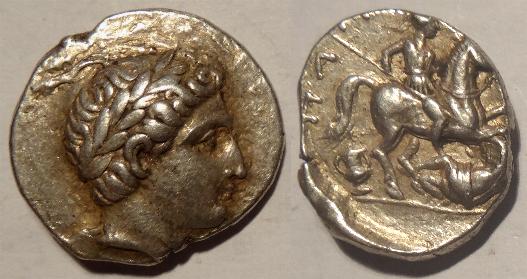
The silver tetradrachm was minted 340-315BC. The obverse features a wreathed laureated Apollo. The reverse has an equestrian warrior with retrograde legend ΠA-TPAOY. There is a figure behind the horse's rear leg that looks like a jug (?). The coin measures 24mm and weighs 12.5 grams.
Euboia ca 340BC
EUBOEA is the second largest Greek island in area and population, after Crete. The narrow Euripus Strait separates it from Boeotia in mainland Greece. It is mentioned ny Homer, who describes it as rich in vines and held by Abantes. During a revolt against Athens of Pericles, Histiaeans killed the crew of an Athenian ship and on the expulsion by the Athenians of Histiaeans, who withdrew to Macedonia, it was renamed Oreus, an Athenian colony
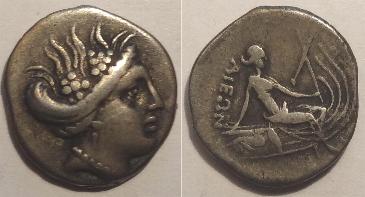
This tetrobol (four obol) silver coin was minted in 340-330BC.
Obverse has a head of nymph Histiaia wreathed with vine, hair rolled
facing right, Reverse has nymph Histiaia seated facing left on a galley holding a pole.The
legend ΑΙΕΩΝ
MACEDONIA ca 336BC
Macedonia was an ancient Greek kingdom. The kingdom, centered in the northeastern part of the Greek peninsula, was bordered by Epirus to the west, Paeonia to the north, the region of Thrace to the east and Thessaly to the south. The rise of Macedon, from a small kingdom at the periphery of Classical Greek affairs, to one which came to dominate the entire Hellenic world, occurred under the reign of Philip II, father of Alexander the Great.
Alexander was probably the ruler who had most prolific number of coins issued under his authority. They were minted in many denominations, in base metals as well as silver and gold. They were issued from mints throughout the world that he conquered. Attribution of these mints is difficult as their mint marks are figures or monograms and the minter is likewise represented by monograms. Some have been attributed by the finding of hoards in specific locales.
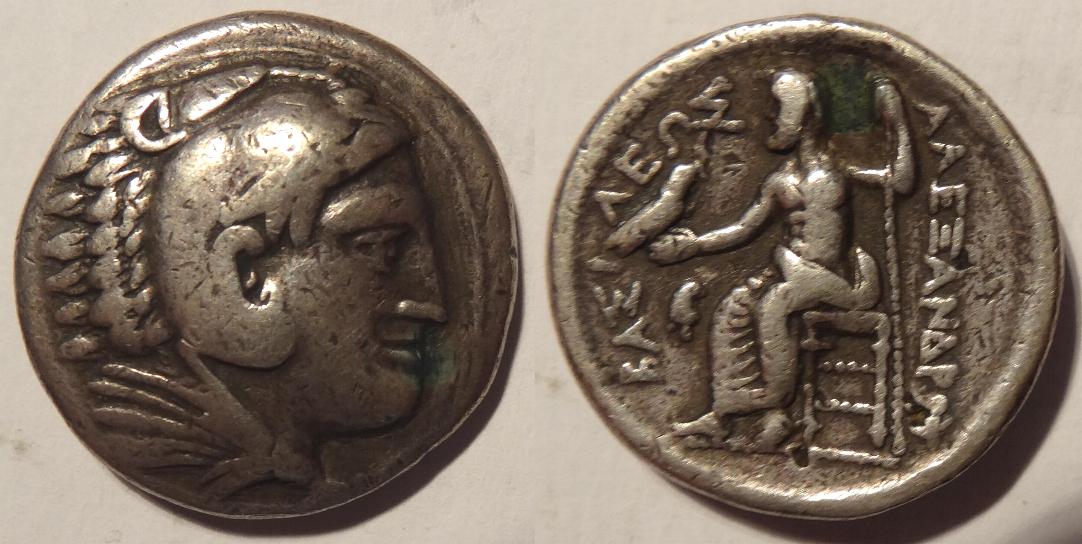
This silver tetradrachm is of Alexander the Great. It is a lifetime issue as denoted by the legs being straight. It was minted from 335-323BC. The obverse has a laureated bust of Heracles in a lion's pelt. The reverse has Zeus sitting on a backless throne with a bird on his right arm and holding a staff in his left. The Greek legend ΑΛΕΞΑΝΔΡΟΥ is to the right and the Greek title ΒΑΣΙ - ΛΕΥΣ is to the left. There is a monogram of a bird's head under the right arm. The coin measures 25mm and weighs 16.5 grams.
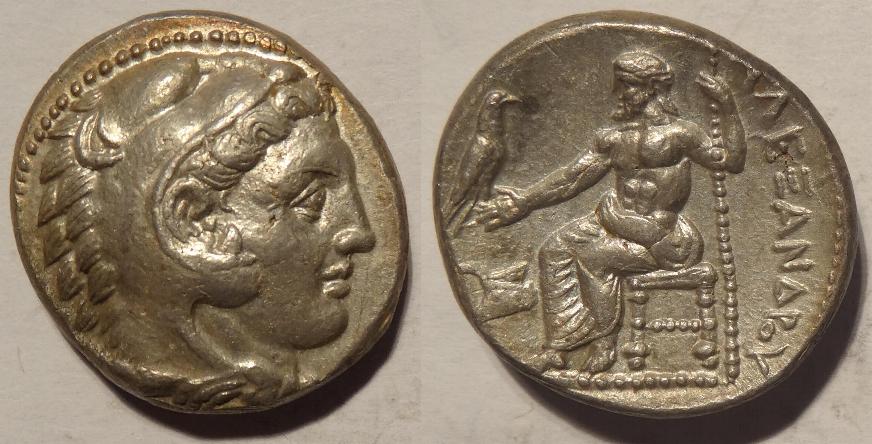
This silver tetradrachm is of Alexander the Great. It is a lifetime issue as denoted by the legs being straight. It was minted from 335-323BC. The obverse has a laureated bust of Heracles in a lion's pelt. The reverse has Zeus sitting on a backless throne with a bird on his right arm and holding a staff in his left. The Greek legend ΑΛΕΞΑΝΔΡΟΥ is to the right. There is a monogram of a ship's prow under the right arm. The coin measures 23mm. The coin is in almost as issued condition.
This is another silver tetradrachm of Alexander the Great. It is a lifetime issue as denoted by the legs being straight. It was minted from 335-323BC. The obverse has a laureated bust of Heracles in a lion's pelt. The reverse has Zeus sitting on a backless throne with a bird on his right arm and holding a staff in his left. The Greek legend ΑΛΕΞΑΝΔΡΟΥ is to the right and the Greek title ΒΑΣΙ - ΛΕΥΣ is to the left. There is a monogram under the right arm. The coin measures 23mm and weighs 16.5 grams.
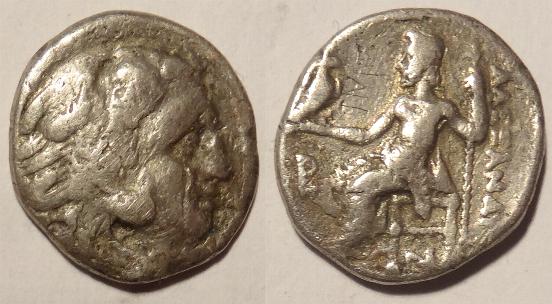
This is a silver drachma issued in the name of Alexander the Great. It is a posthumous issue (since the legs are crossed). The obverse has a laureated bust of Heracles in a lion's pelt. The reverse has Zeus sitting on a backless throne with a bird on his right arm and holding a staff in his left. The Greek legend ΑΛΕΞΑΝΔΡΟΥ is to the right. There is a monogram of a bird under the right arm and a monogram under the throne. The coin measures 16mm and weighs 4 grams.
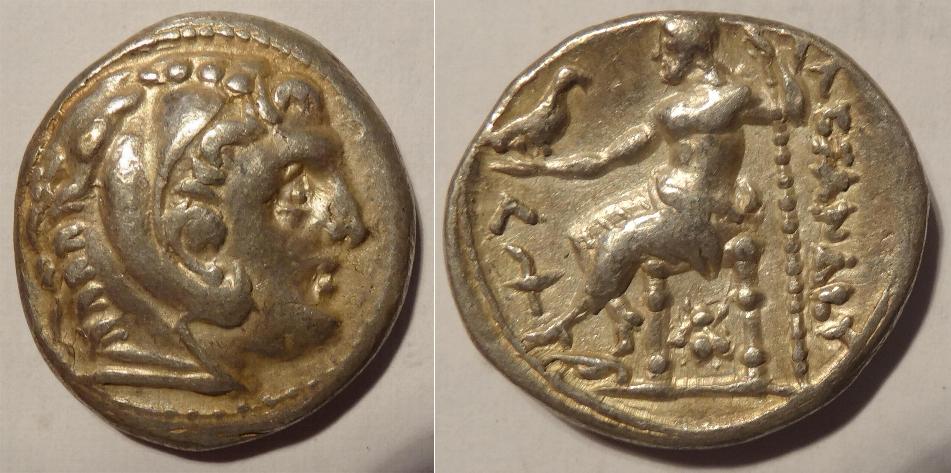
This is a silver tetradrachm issued in the name of Alexander the Great. It is a posthumous issue (since the legs are crossed). The obverse has a laureated bust of Heracles in a lion's pelt. The reverse has Zeus sitting on a backless throne with a bird on his right arm and holding a staff in his left. The Greek legend ΑΛΕΞΑΝΔΡΟΥ is to the right. There is a monogram of a Λ and a symbol under the right arm and a monogram under the throne. The coin measures 26mm
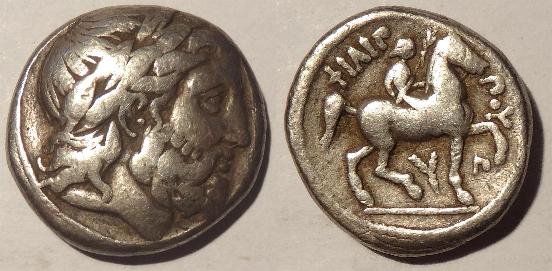
This silver tetradrachm of Philip II, father of Alexander the Great. This coin was minted in Amphipolis from 323-316BC, it is posthumous minting. The obverse has a laureated head of Zeus. The reverse has a naked boy on a horse with the Greek legend ΦΙΛΙΠ - ΠΟΥ. There is a laurel branch under the body of the horse and a Greek Letter Π below the upraised left leg. The coin measures 23mm and weighs 14 grams.
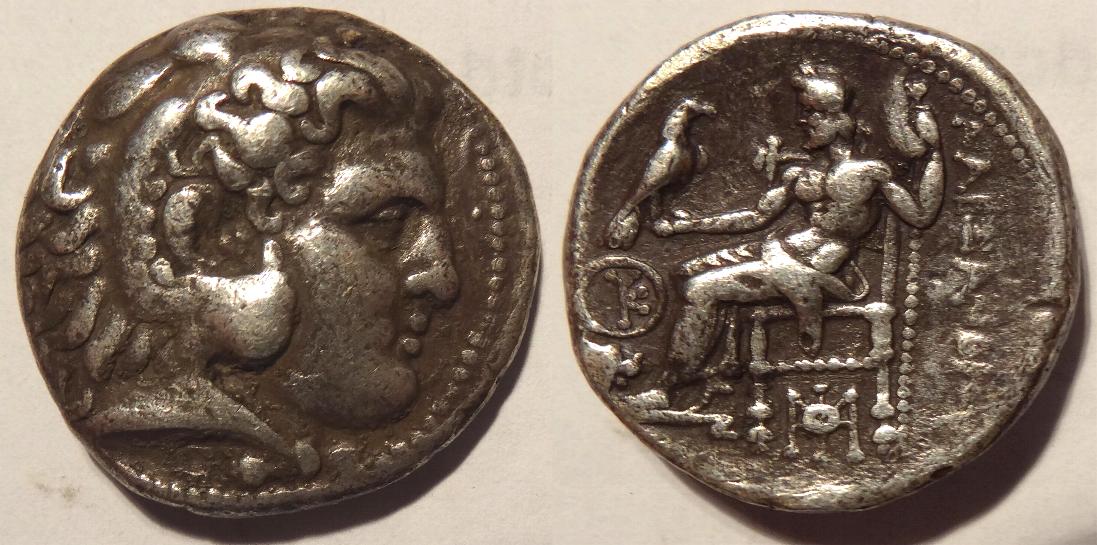
This is another silver tetradrachm of Alexander the Great. It is a posthumous as denoted by the legs being crossed. It was minted after 323BC. The obverse has a laureated bust of Heracles in a lion's pelt. The reverse has Zeus sitting on a throne with a bird on his right arm and holding a staff in his left. The Greek legend ΑΛΕΞΑΝΔΡΟΥ is to the right. There is a monogram under the right arm band another under the throne. The coin measures 25mm and weighs 16.5 grams.
MAGNESIA, THESSALY - ca 323
The name Magnesia is derived from the name of the first settlers in the region, the Magnetes. The geographic size of Magnesia encompasses about 750 square miles. In mythology, Pelion was the place that was chosen by the Gods of Olympus for their summer vacations, their festivities and their ceremonies. The marriage between Pelia and Thetitha took place here, and Homer, Pindaros and Evripides spoke of this in their stories. Pelion was also home to the centaurs, the half horse and half man creatures, with the most famous being the centaur Chiron. Chiron was a very intelligent being and was teacher to Achilles and Hercules, as well ashaving taught medicine to Asclepios. It was also from Pelion that the boat Argos set sail to Colhiva, with Jason and the Argonauts on board looking for the Golden Fleece. Archaeological research in the area has brought to light Mesolithic findings. In the areas of Sesklo and Dimini, Neolithic artefacts and ancient ruins were discovered. Researchers also discovered Mikinike cities spread throughout the whole of Magnesia, which, in their time, were very prosperous cities in Greece
This silver tetradrachm of Alexander the Great. It is a posthumous issue as denoted by the legs being crossed. It was minted after 323BC. The obverse has a laureated bust of Heracles in a lion's pelt. The reverse has Zeus sitting on a throne with a bird on his right arm and holding a staff in his left. The Greek legend ΑΛΕΞΑΝΔΡΟΥ is to the right. There is a monogram of a ship's prow under the right arm. The coin measures 23mm and weighs 16.5 grams. This coin is "as struck."
LYSIMACHOS ca309BC
LYSIMACHOS was built by Lysimachus in 309BC, near the site of Cardia, which he had destroyed. From its position near the narrowest part of the isthmus it became the key of the Chersonesus, and commanded also the passage of the Hellespont. Lysimachus made it his residence and his principal European mint. After his death the town fell under the rule first of the Seleucids and then of the Ptolemies, but it probably retained its right of coining in bronze.
This bronze coin was minted about 309-237BC. The obverse has a head of Athena in a Corinthian helmet The reverse has a lion springing to the right with the Greek legend LUSIMACEWN below.
TARENTUM ca 270BC
TARENTUM was founded in 706 BC by Dorian immigrants as the only Spartan colony, and its origin is peculiar: the founders were Partheniae, sons of unmarried Spartan women and perioeci (free men, but not citizens of Sparta); these unions were decreed by the Spartans to increase the number of soldiers (only the citizens of Sparta could become soldiers) during the bloody Messenian Wars, but later they were nullified, and the sons were forced to leave. According to the legend Phalanthus, the Parthenian leader, went to Delphi to consult the oracle and received the puzzling answer that he should found a city where rain fell from a clear sky. After all attempts to capture a suitable place to found a colony failed, he became despondent, convinced that the oracle had told him something that was impossible, and was consoled by his wife. She laid his head in her lap and herself became disconsolate. When Phalanthus felt her tears splash onto his forehead he at last grasped the meaning of the oracle, for his wife's name meant clear sky. The harbour of Taranto in Apulia was nearby and he decided this must be the new home for the exiles. The Partheniae arrived and founded the city, naming it Taras after the son of the Greek sea god, Poseidon, and the local nymph Satyrion. The symbol of the Greek city (as well as of the modern city) is Taras riding a dolphin. Tarentum (now Taranto) increased its power, becoming a commercial power and a sovereign city of Magna Graecia, ruling over the Greek colonies in southern Italy.
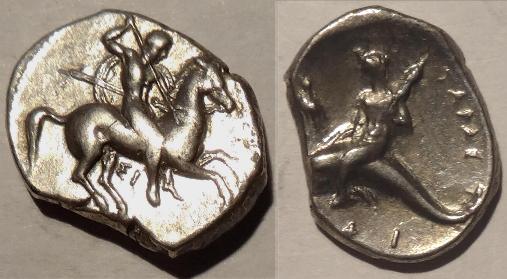
This silver coin is a didrachm (two drachma piece). It was
minted from 272-235 BC. The obverse has a naked warrior horseman carrying a
shield and spear facing right with the Greek letters ΣΙ beneath. The reverse has Taras riding on a doplhin
facing left with ΤΑΡΑΣ
CARTHAGE ca 250BC
Carthage was the center of the Carthaginian Empire in antiquity. The city has existed for nearly 3,000 years, developing from a Phoenician colony of the 1st millennium BC into the capital of an ancient empire. According to Greek historians, Carthage was founded by Canaanite-speaking Phoenician colonists from Tyre (in modern Lebanon). It became a large and rich city and thus a major power in the Mediterranean. The resulting rivalry with Syracuse, Numidia, and Rome was accompanied by several wars with respective invasions of each other's homeland. Hannibal's invasion of Italy in the Second Punic War culminated in the Carthaginian victory at Cannae and led to a serious threat to the continuation of Roman rule over Italy. Carthage emerged from the conflict weaker after Hannibal's defeat at the Battle of Zama in 202BC. Following the Third Punic War, the city was destroyed by the Romans in 146BC. However, the Romans refounded Carthage, which became the empire's fourth most important city and the second most important city in the Latin West. It later became the capital of the short-lived Vandal kingdom. It remained one of the most important Roman cities until the Muslim conquest when it was destroyed a second time in 698AD.
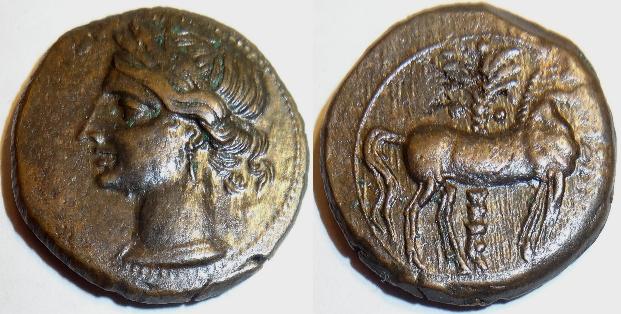
This bronze coin was minted in Zeugitana, Carthage around 250 BC. The obverse has the head of of the Carthiginian goddess Tanit wearing earrings and necklace, facing left, wreathed with corn. The reverse has a standing horse facing right with a palm tree in the background. Most Carthiginian coins of the period had Tanit on the obverse and a horse or horse head on the reverse. The coin measures 22mm.
SIDON, PHOENICIA ca 250BC
Sidon was founded during the Early Bronze Age of the third millennium BC, when it was settled by coastal populations in its natural anchorage. By the beginning of the early Iron Age (between about 1200-1000 BC), Sidon had become an important international trade center.It is still a major port in Lebanon.
This is a silver tetradrachm minted in 250BC in Sidon. It measures 26mm and weighs 14 grams. The obverse features a diademed head of Ptolemy II wearing an aegis (breastplate). The reverse has the legend ΠΤΟΛΕΜΑΙΟΥ ΣΟΤΗΡΟΣ , an eagle standing to left with ΣI (for Sidon) and MT monogram in left field, and ΛE (regnal year 5) in right field.
Epirote Republic ca 238BC
Epirus was the north-west area of ancient Greece. It was inhabited by the Greek tribes of the Chaonians, Molossians, and Thesprotians, and home to the sanctuary of Dodona, the oldest ancient Greek oracle, and the most prestigious one after Delphi. Unified into a single state in 370BC by the Aeacidae dynasty, Epirus achieved fame during the reign of Pyrrhus of Epirus, whose campaigns against Rome are the origin of the term "Pyrrhic victory". The Aeacid dynasty ended in 232BC, but Epirus remained a substantial power, unified under the auspices of the Epirote League as a federal state with its own parliament. Epirus subsequently became part of the Roman Empire along with the rest of Greece in 146BC.
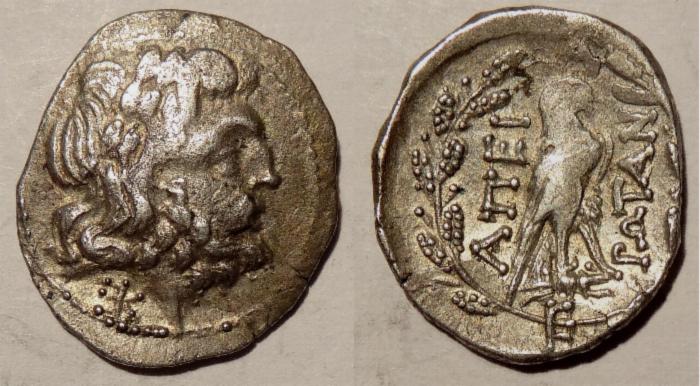
This is a silver drachm issued by the Epirote Republic from 238-168BC, The obverse has the head of Zeus Dodonaios with an EK monogram beneath the bust The reverse has an eagle standing facing right on a thuderbolt within an oak wreath with APEI-RWTWN. The coin measures 20mm and weighs 5 grams.
Epidamnos-Dyrrhachium, Illyria ca 229BC
EPIDAMNOS, later the Roman Dyrrachium (modern Durrës, Albania) was founded in 627BC in Illyria by a group of colonists from Corinth and Corcyra (modern Corfu). Aristotle's Politics several times draws for examples on the internal government of Epidamnos, which was run as a tight oligarchy that appointed a ruling magistrate. Tradesmen and craftsmen were excluded from power until internal strife produced a more democratic government. The exiled oligarchs appealed to Corcyra while the democrats enlisted the help of Corinth, initiating a struggle between the two mother cities described by Thucydides as a cause of the Peloponnesian War. Individual trading with the local Illyrians was forbidden at Epidamnos, all business was through the authorized city agent or poletes. In the fourth century BC the city-state was part of the kingdoms of Cassander and Pyrrhus.
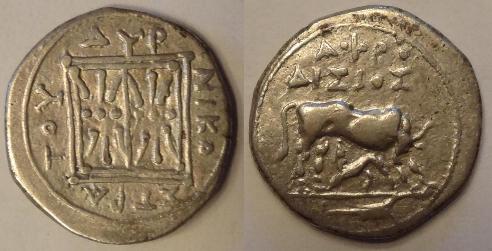
This is a silver drachm. It was minted after 229BC, Obverse has Greek legend DUR
NIKO STRA TOU
Brettian League ca 215BC
Bruttium was a region in the "toe" of Italy, roughly corresponding to modern Calabria. The name comes from the ancient tribe of Bruttii, who occupied the area before the Greeks colonized it beginning in the 8th century BC. The Bruttii retained their independence until 280BC, when they helped the Greek king Pyrrhus of Epirus in his war against the Romans. After defeating Pyrrhus, the Romans invaded Bruttium and occupied most of the country. The Bruttii aided the Carthaginian general Hannibal during the Second Punic War (218-201BC), resulting in their final crushing as an separate entity.
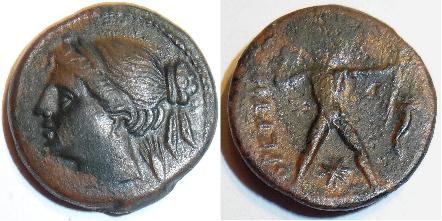
This small bronze coin was issued in Bruttium around 215-205BC. The reverse features a left facing head of Nike. The reverse has a standing Zeus hurling a thunderbolt with BRETTI-WN to the left. Zeus has an asterisk like monogram between his legs and there is a cornucopia in the right field. The coin measures 16mm and weighs about 5 grams.
PARTHIA - ca 215BC
The Parthian Empire (247BC–224AD), also known as the Arsacid Empire was a major Iranian political and cultural power in ancient Persia. Its latter name comes from Arsaces I of Parthia who, as leader of the Parni tribe, founded it in the mid-3rd century BC when he conquered the region of Parthia in Persia's northeast, then a satrapy (province) in rebellion against the Seleucid Empire. Mithridates I of Parthia (171–138BC) greatly expanded the empire by seizing Media and Mesopotamia from the Seleucids. At its height, the Parthian Empire stretched from the northern reaches of the Euphrates, in what is now southeastern Turkey, to eastern Persia. The empire, located on the Silk Road trade route between the Roman Empire in the Mediterranean Basin and the Han Empire of China, became a center of trade and commerce. The Parthians largely adopted the art, architecture, religious beliefs, and royal insignia of their culturally heterogeneous empire, which encompassed Persian, Hellenistic, and regional cultures. For about the first half of its existence, the Arsacid court adopted elements of Greek culture, though it eventually saw a gradual revival of Iranian traditions.
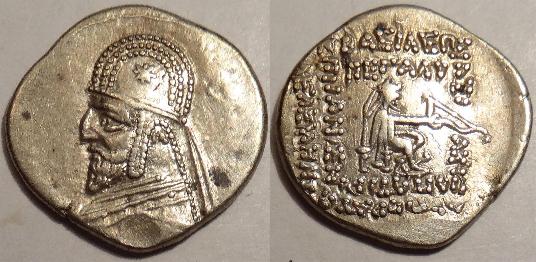
This is a silver drachma minted by Sinatruces at Ecbatana in 77-70BC. The obverse has a crowned bust facing left, short beard, a pendant at the ear. The reverse has an archer seated right on a throne, holding a bow with the right hand. Some of the legend is visible BASILEWS MEGALOU (above) ARSAKOU (right) ΕΠΙΦΑΝΟΥΣ ΦΙΛΕΛΛΗΝΟΣ (left) the bottom is unintelligible to me. The coin measures 19mm.
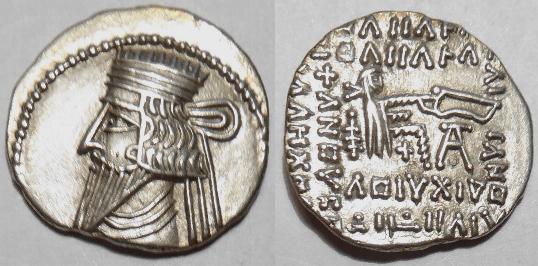
This is a silver drachma minted by Vologases III at Ecbatana in 105-147AD. The obverse has a bust facing left, bare head, triple head band, with a bow who falls behind the head, the hair falling on the neck, short and pointed beard, a pendant at the ear. The reverse has an archer seated right on a throne, holding a bow with the right hand, under the bow, an A like monogram. The legend is in blundered Greek by an engraver obviously not fluent in written Greek. The coin measures 19mm.
BOLSKAN, IBERIA ca 204-154BC
Huesca's pre-Roman Iberian name was Bolskan. It was the capital of the Ilergetes, in the north of Hispania Tarraconensis, on the road from Tarraco (modern Tarragona) and Ilerda (modern Lleida) to Caesaraugusta (modern Zaragoza) and fell under Caesaraugusta's jurisdiction. Pliny alone places the Oscenses in Vescitania, a district mentioned nowhere else. The city's name was rendered as Osca, and was a Roman colony. Phoenician and Greek contact with Spain stretched back to the Seventh Century BC at least; possibly several centuries earlier in the case of the Phoenicians. A lively trade was carried on with the rich mining culture based on the city of Tartessos, but about 500BC the Carthaginians destroyed Tartessos having already taken control of the Phoenician settlements in Spain. Carthaginian pre-eminence in southern and eastern Spain lasted until the time of the Punic Wars between Carthage and Rome. It was from Spain that Hannibal launched his famous invasion of Italy which came so close to destroying the Roman Republic in the infancy of its power. But Hannibal was defeated and Spain became a Roman province (206BC). During the Second Century BC, Rome gradually extended her influence into the interior of the country and permitted the Iberian tribes to issue a native currency bearing Iberian legends. This coinage ceased with the provincial reforms carried out in 133BC. The various civil wars in Spain in the First Century BC saw the temporary revival of bronze issues from certain mints. It was not until 19BC, in the reign of Augustus, that the whole of the peninsula came under Roman control with the conquest of northwestern Spain.

This is a silver drachm minted by the Osca tribes in 204-154BC on the Iberian Peninsula. The obverse has a male head right with short beard, a legend resembling '*Y' behind. The reverse has a horseman galloping right with spear with an Iberian legend resembling '*PMAN' = BOLSCAN below. The coin measures 20mm and weighs about 4 grams.
Abbaitis, PHRYGIA ca 200BC
In antiquity, Phrygia was a kingdom in the west central part of Anatolia, in what is now Turkey, centered around the Sakarya River. The Phrygians are most famous for their legendary kings of the heroic age of Greek mythology: Gordias whose Gordian Knot would later be untied by Alexander the Great; Midas who turned whatever he touched to gold; and Mygdon who warred with the Amazons. According to Homer's Iliad, the Phrygians were close allies of the Trojans and participants in the Trojan War against the Achaeans. Phrygian power reached its peak in the late 8th century BC under another, historical king Midas, who dominated most of western and central Anatolia and rivaled Assyria and Urartu for power in eastern Anatolia. This later Midas was, however, also the last independent king of Phrygia before its capital Gordium was sacked by Cimmerians around 695BC. Phrygia then became subject to Lydia, and then successively to Persia, Alexander and his Hellenistic successors, Pergamon, Rome and Byzantium. Phrygians were gradually assimilated into other cultures by the early medieval era.
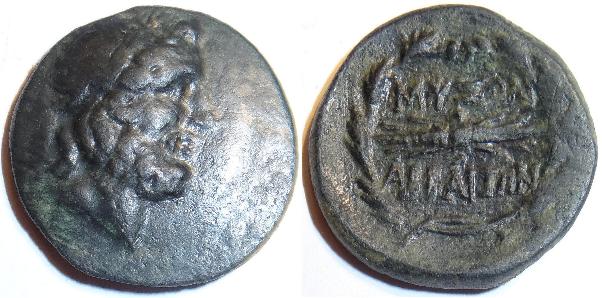
This small bronze coin was minted about 200-100BC in Abbaitis. The obverse has the laureate head of Zeus facing right The reverse has MUSWN ABBAITWN above and below winged thunderbolt, all within an oak wreath. The coin measures 20mm.
EPHESUS, IONIA ca 200BC
Ephesus was an ancient Greek city on the coast of Ionia, three kilometers southwest of present-day Selçuk in Izmir Province, Turkey. It was built in the 10th century BC on the site of the former Arzawan capital by Attic and Ionian Greek colonists. During the Classical Greek era it was one of the twelve cities of the Ionian League. The city flourished after it came under the control of the Roman Republic in 129 BC. According to estimates Ephesus had a population of 33,600 to 56,000 people in the Roman period, making it the third largest city of Roman Asia Minor. Ephesus can be visited today and a small percentage of the ancient city has been excavated to reveal the splendour of this ancient site.
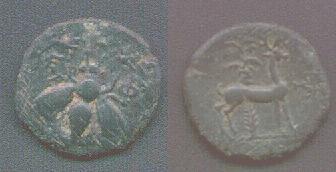
The small 18mm bronze coin has a honeybee (symbol of Ephesus) in a wreath with the Greek letters Ε and Φ on the obverse and a standing stag with a palm tree in the background on the reverse. This coin was minted from 202-133BC.
MASSILIA, GAUL: - ca 200BC
The first permanent Greek settlement in France, and the oldest city, was called Massalia, established at modern-day Marseille about 600BC by colonists coming from Phocaea on the Aegean coast of Asia Minor. A second wave of colonists arrived in about 540, when Phocaea was destroyed by the Persians. The city became one of the major trading ports of the ancient world. At its height, in the 4th century BC, it had a population of about 6,000 inhabitants, on about 0.2 square miles surrounded by a wall. It was governed as an artistocratic republic, by an assembly of the 600 wealthiest citizens. It had a large temple of the cult of Apollo of Delphi on a hilltop overlooking the port, and a temple of the cult of Artemis of Ephesus at the other end of the city. The drachma coins minted in Massalia were found in all parts of Ligurian-Celtic Gaul. Massalia allied itself with the expanding Roman Republic for protection. Under this arrangement the city maintained its independence until the rise of Julius Caesar, when it joined the losing side (Pompey and the optimates) in civil war, and lost its independence in 49 BC.
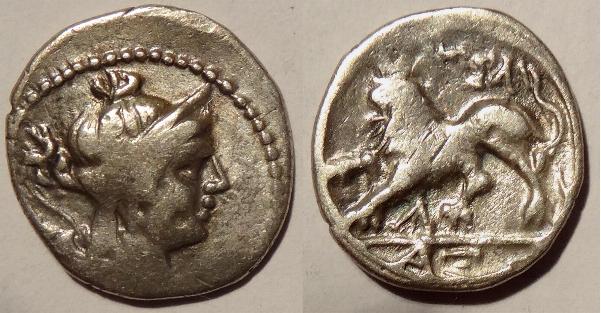
This is a silver drachm issued around 200 BC. It measures 17mm
and weighs about 2.5 grams. The obverse features a diademed and draped bust of Artemis
facing right with a bow and quiver at the shoulder. The reverse has a lion
standing facing left, ΜΑΣΣΑ
MYRINA, AEOLIS ca 200BC
Myrina was one of the Aeolian cities on the western coast of Mysia. It is said to have been founded by one Myrinus before the other Aeolian cities, or by the Amazon Myrina. Artaxerxes gave Gryneium and Myrina to Gongylus, an Eretrian, who had been banished from his native city for favoring the interests of Persia. Myrina was a very strong place, though not very large, and had a good harbor. Pliny mentions that it bore the surname of Sebastopolis; while, according to Syncellus, it was also called Smyrna. An ancient inscription tells us that Myrina formed part of the Kingdom of Pergamon in the 3rd century BC. For some time Myrina was occupied by Philip V of Macedon; but the Romans compelled him to evacuate it, and declared the place free.
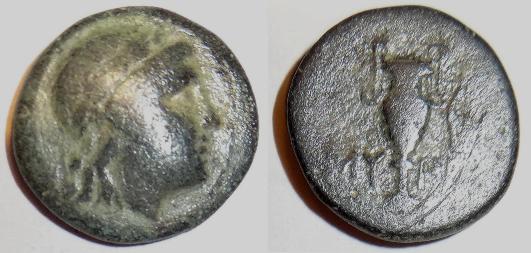
This small bronze coin was minted in Myrina around 200-100BC, The obverse has the head. of Athena facing right in a crested helmet ornamented with a griffin. The reverse has an amphora and a lyre to the right with the Greek legend ΜΥΡΙ. The coin measures 16mm and has an attractive green patina.
PERGE, PAMPHYLIA ca 200BC
Perge was an ancient Greek city in Anatolia, once the capital of Pamphylia Secunda, in today's Antalya province on the southwestern Mediterranean coast of Turkey. The region of Pamphylia first enters history in Hittite documents. In a treaty between the Hittite Great King Tudhaliya IV and his vassal, the king of Tarhuntassa, we read of the city "Parha" (Perge). The first historical mention of "Pamphylians" is among the group of nations subdued by the Mermnad kings of Lydia; they afterwards passed in succession under the dominion of the Persian and Hellenistic monarchs. After the defeat of Antiochus III in 190BC, they were included among the provinces annexed by the Romans to the dominions of Eumenes of Pergamum. Somewhat later they joined with the Pisidians and Cilicians in piratical ravages. Pamphylia was for a short time included in the dominions of Amyntas, king of Galatia, but after his death lapsed into a district of a Roman province
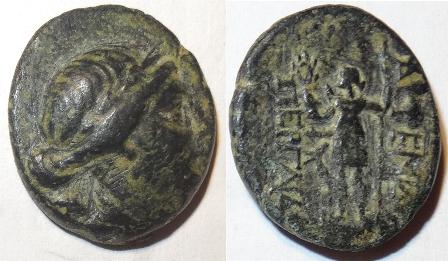
This small bronze coin was minted about 200-100BC. The obverse has a laureated head of Artemis facing right with a quiver behind the neck neck. The reverse has Artemis standing holding a wreath and scepter with a stag at her feet. The legends ARTEMIDOS and PERGAIAS respecively to the right and the left. The coin measures 17mm.
Cilicia, Seleukeia ca 200 BC
Seleucia ad Calycadnum or Seleukeia is on the Kalykadno River, near the Mediterranean coast in Cilicia; modern Silifke, Turkey. It was founded by of Seleukos I sometime after 295BC, when the king conquered Cilicia on his way to Macedonia.
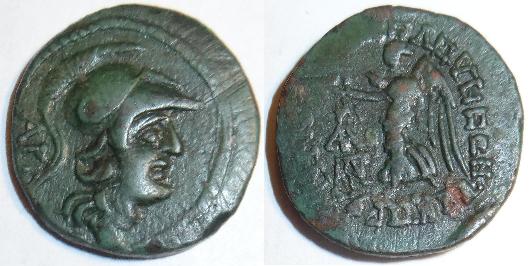
This bronxe coin was minted from 200-100BC. The obverse has the
helmeted head of Athena in a crested Corinthian helmet with ΑΓΩ
SIDE, PAMPHYLIA ca 200BC
Side was founded by Greek settlers from Cyme in Aeolis, a region of western Anatolia. This most likely occurred in the 7th century BC. Its tutelary deity was Athena, whose head adorned its coinage. Alexander the Great occupied Side without a struggle in 333 BC. Alexander left only a single garrison behind to occupy the city. This occupation, in turn, introduced the people of Side to Hellenistic culture, which flourished from the 4th to the 1st century BC. After Alexander's death, Side fell under the control of one of Alexander's generals, Ptolemy I Soter, who declared himself king of Egypt in 305 BC. Pamphylia was the region in the south of Asia Minor, between Lycia and Cilicia, extending from the Mediterranean to Mount Taurus.
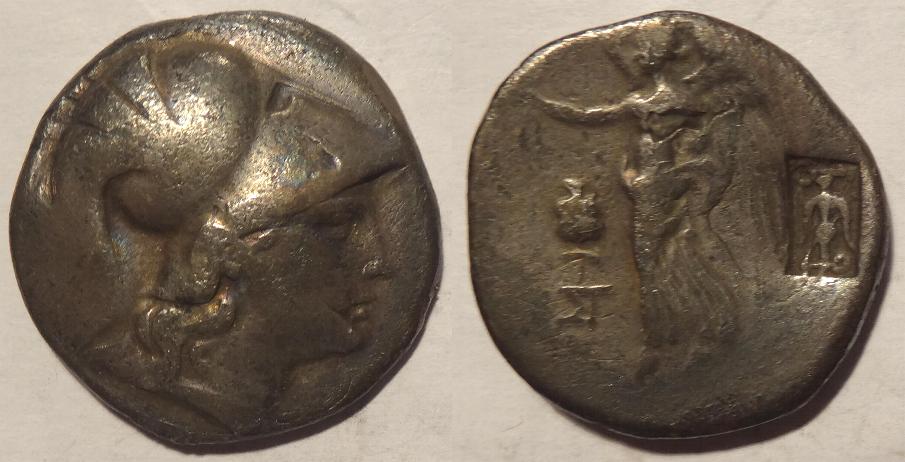
This is a silver tetradrachm minted in Side around 200BC. The obverse has the head of Athena in a crested Corinthian helmet facing right . The reverse has Nike advancing in field to the left. There is a counterstamp of an upside down anchor in an incuse square to the right and a pomegranate to left with a monogram identifier for the magistrate of the Greek letters ΣΤ below. The coin measures 16mm.
ODESSOS, THRACE - ca 200BC
The region of ancient Thrace was populated by Thracians by 1000BC. Miletian Greeks founded the apoikia (trading post) of Odessòs towards the end of the 7th century BC (the earliest Greek archaeological material is dated 600–575BC) within an earlier Thracian settlement. The name Odessos was pre-Greek, arguably of Carian origin. A member of the Pontic Pentapolis, Odessos was a mixed community—contact zone between the Ionian Greeks and the Thracian tribes (Getae, Krobyzoi, Terizi) of the hinterland. Excavations at nearby Thracian sites have shown uninterrupted occupation from the 7th to the 4th century and close commercial relations with the colony. The Greek alphabet has been applied to inscriptions in Thracian since at least the 5th century BCE; the city worshipped a Thracian great god whose cult survived well into the Roman period. It is located at current day Varna, in Bulgaria.
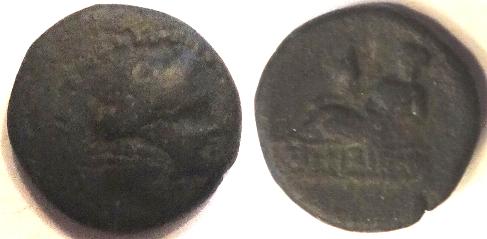
This bronze coin was minted about 200BC. The obverse features the right-facing laureate head of Apollo. The reverse has the great ood reclining left with the legend ODHSITWN below. The coin measures 15mm.
Thessalian LEAGUE ca 194BC
The Thessalian League was a loose confederacy of feudal-like city-states and tribes in the Thessalian valley in Northern Greece and was run by a few aristocratic Thessalian families
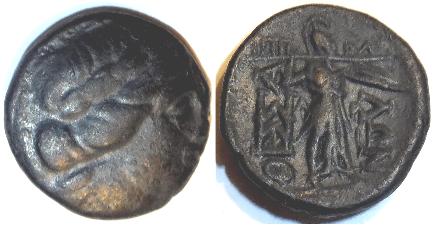
This bronze coin was issued around 194-146BC. The obverse has a laureate head of Apollo facing right. The reverse has Athena Itonia standing facing right with shield, about to hurl a spear. The Greek legend ΘΕΣΣΑ-ΛΩΝ is on the lower sides of the coin. The magistrate's name is above. The coin measures 20mm.
BACTRIA ca 171BC
Bactria is the ancient name of a historical region located south of the Amu Darya and west of Gandhara. Ancient Bactria was in present-day northern Afghanistan, between the Hindu Kush mountain range and the Amu Darya. It is suggested by E. Herzfeld that, prior to its annexation to the Persian Empire by Cyrus the Great in 6th century BC, Bactria belonged to the Median empire and together with Margiana formed the twelfth satrapy of Persia. After Darius III had been defeated by Alexander the Great, the satrap of Bactria, Bessus, attempted to organize a national resistance but was captured by other warlords and delivered to Alexander. He was then tortured and killed. Alexander conquered Sogdiana and Iran. However, in the south, beyond the Oxus, he met strong resistance. After two years of war and a strong insurgency campaign, Alexander managed to establish little control over Bactria. After Alexander's death, the Macedonian empire was eventually divided up between generals in Alexander's army. Bactria became a part of the Seleucid Empire, named after its founder, Seleucus I. The Greek language became dominant for some time there. The paradox that Greek presence was more prominent in Bactria than in areas far closer to Greece can possibly be explained by past deportations of Greeks to Bactria. For instance, during the reign of Darius I, the inhabitants of the Greek city of Barca, in Cyrenaica, were deported to Bactria for refusing to surrender assassins. In addition, Xerxes also settled the "Branchidae" in Bactria; they were the descendants of Greek priests who had once lived near Didyma (western Asia Minor) and betrayed the temple to him. Herodotus also records a Persian commander threatening to enslave daughters of the revolting Ionians and send them to Bactria..
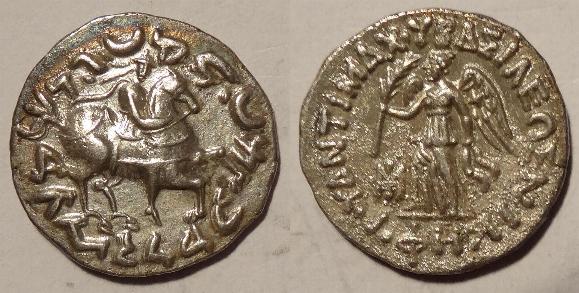
This is a silver drachm minted in 171-160BC for Antimachos. The obverse has the armed horseman king surrounded by a Karoshi legend. The reverse has Nike standing with the Greek legend BASILEWS NIKHFOROU ANTIMACOU. There is a monogram to the lower left of Nike. The coin measures 16mm.
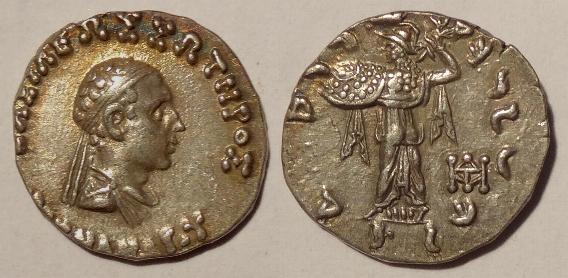
This silver drachma was minted for Menander around 160-145 BC. The obverse features a diademed and draped bust facing right with the Greek legend BASILEWS SWTHEROS MENANDPOU. The reverse has Athena advancing left, bearing shield and thunderbolt with Karosthi legend. There is a monogram in the lower right field. The coin measures 21 mm.
RHODES ca 160BC
Rhodes was founded in 408BC and is an island just off the coast of western Turkey. The Colossus of Rhodes, one of the original Seven Wonders of the Ancient World, was built by the Lindian sculptor Chares between 304 and 293BC. It took 12 years and was completed in 282BC. The statue represented their sun god Helios, which stood at the harbour entrance. A strong earthquake hit Rhodes about 226BC, badly damaging the city and toppling the Colossus. For the next eight centuries it lay in ruins until it was sold to a Jewish merchant, reputed to require 900 camels to haul it away. In 164BC, Rhodes came under Roman control. During WWII, it was occupied by Italy and after the war, reverted to Greece.
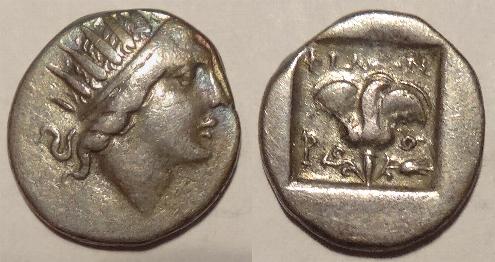
This small silver coin is a drachma. The obverse
has a radiate head of Helios facing right. The reverse has the rose symbol of
Rhodes, magistrate's symbol, ΦΙΛΩΝ
THASOS ca 148
Thasos is a Greek island in the northern Aegean Sea, close to the coast of Thrace and the plain of the river Nestos but geographically part of Macedonia. It is the northernmost Greek island, and 12th largest by area. The island was colonized at an early date by Phoenicians, attracted probably by its gold mines. They founded a temple to the god Melqart, whom the Greeks identified as "Tyrian Heracles", and whose cult was merged with Heracles in the course of the island's Hellenization. Around 650BC, or a little earlier, Greeks from Paros founded a colony on Thasos. Thasian coins had the head of the wine god Dionysos on one side and bunches of grapes on the other. Thasos was important during the Ionian Revolt against Persia. After the capture of Miletus (494BC) Histiaeus, the Ionian leader, laid siege. The attack failed but, warned by the danger, the Thasians employed their revenues to build war ships and strengthen their fortifications. This excited the suspicions of the Persians, and Darius compelled them to surrender their ships and pull down their walls. After the defeat of Xerxes the Thasians joined the Delian confederacy; but afterwards, on account of a difference about the mines and marts on the mainland, they revolted. The Athenians defeated them by sea, and, after a siege that lasted more than two years, took the capital, Thasos, probably in 463BC, and compelled the Thasians to destroy their walls, surrender their ships, pay an indemnity and an annual contribution (in 449BC this was 21 talents (a Greek talent weighed 26 kilograms (57 lb) of silver), from 445BC about 30 talents), and give ip their possessions on the mainland. In 411BC, at the time of the oligarchical revolution at Athens, Thasos again revolted from Athens and received a Lacedaemonian governor. In 407BC the partisans of Lacedaemon were expelled and the Athenians, under Thrasybulus, were admitted. After the Battle of Aegospotami (405BC), Thasos again fell into the hands of the Lacedaemonians under Lysander who formed a decarchy (ten men oligarchy) there. Later the Athenians must have recovered it, for it formed one of the subjects of dispute between them and Philip II of Macedonia. In the embroilment between Philip V of Macedonia and the Romans, Thasos submitted to Philip, but received its freedom at the hands of the Romans after the Battle of Cynoscephalae (197BC), and it was still a "free" state in the time of Pliny.
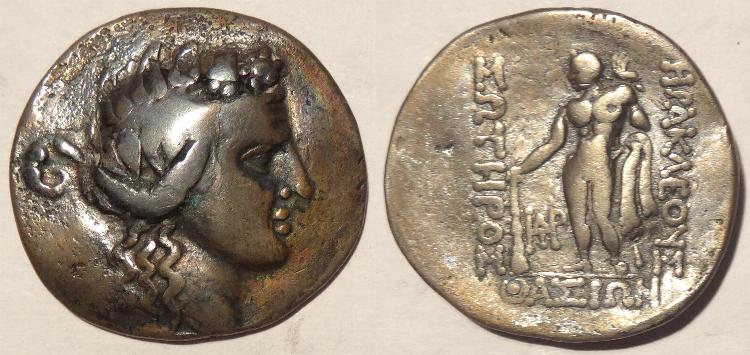
This is a silver tetradrachm minted in Thasos around 148BC.
The obverse portrait is of a young Dionysus crowned with vines facing right. The
reverse is of Heracles standing naked, head left, holding a club and lion skin..
The legends, HRAKLEOUS
EUMENEIA ca 133BC
Eumeneia, a town of Phrygia, is situated on the river Glaucus, on the road from Dorylaeum to Apameia. It is said to have received its name from Attalus II., who named the town after his brother and predecessor, Eumenes II.
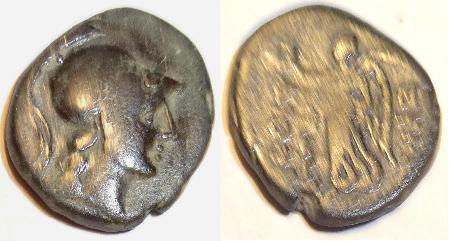
This bronze coin was minted around 133BC. The obverse has a helmeted head of Athena facing right. The reverse has Nike advancing left, holding wreath and palm with the legends ΕΥΜΕ to the right and ΠΔΙΟΦ (magistrate) to the left. The coin measures 19mm.
Laodikeia Paphlagonia ca 133BC
This settlement was founded as a city in the Hellenistic Period. The Hellenistic city was founded by the commander Seleucus Antiochus II after the name of his wife Laodike around the middle of the third century BC. The region later became part of the Roman Republic (after Empire) in 130-129BC. Paphlagonia was a rugged mountainous area on the Black Sea coast of north central Anatolia, between Bithynia to the west and Pontus to the east. Herodotus names the Paphlagonians among the peoples conquered by Croesus, and they sent an important contingent to the army of Xerxes in 480BC After the death of Alexander the Great, it was assigned, together with Cappadocia and Mysia, to Eumenes. However, it continued to be governed by native princes until it was absorbed by Pontus. It was not until 183BC that Pharnaces took Sinope under their control. From that time, the whole province was incorporated into the kingdom of Pontus until the fall of Mithridates to Rome in 65BC.
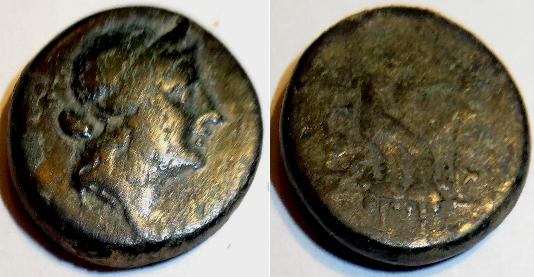
This bronze coin was minted around 133BC. The obverse has a female head facing right, The reverse has a decorated cornucopia with the Greek legend ΛAODI-KEON. The coin measures 20mm.
ARADOS,PHOENICIA - ca 130BC
The island was settled in the early 2nd millennium BC by the Phoenicians. Under Phoenician control, it became an independent kingdom called Arvad or Jazirat (the latter term meaning "island"). The Phoenician name for the city was probably Aynook. In Greek it was known as Arados. It is located off the coast of today's Syria.
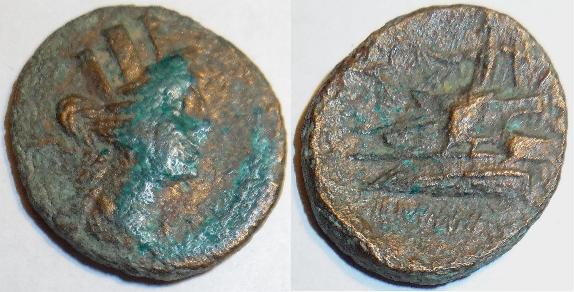
This bronze coin was minted around 130BC. The obverse has a turreted bust of Tyche right facing right, The reverse has Poseidon on prow of ship sailing left, holding wreath and trident with phoenician letters above andphoenician numerals beneath. The coin measures 21mm.
Belikiom, CITERIOR IBERIA - 120BC
Belikiom was the old name of Piquete de la Atalaya de Azuara, an area near present day Zaragosa, Spain.
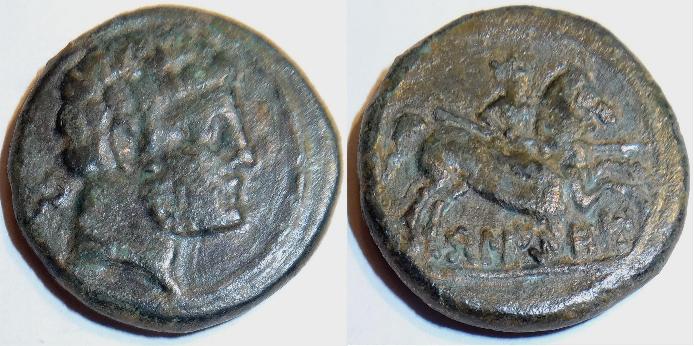
This bronze coin was minted around 120BC. The obverse has a male head facing right with a Celtiberian letter behind. The reverse has a horseman facing right carrying lance with the city's name below in Celtiberian script BELIKIOM. The coin measures 24mm.
CASTULO, IBERIA - ca 120BC
Castulo was located in the Andalusian province of Jaén, in south-central Spain. Oretans was the name of the Iberian tribe which settled in the vicinity in the north of the Guadalquivir River beginning in the 6th century BC. Of tradition, a local princess named Himilce married Hannibal and gained the alliliance of the city with the Carthaginian Empire. In 213BC, Castulo was the site of Hasdrubal Barca's crushing victory over the Roman army with a force of roughly 40,000 Carthaginian troops plus local Iberian mercenaries. Thereafter the Romans made a pact with the residents of city — who then betrayed the Carthaginians — and the city became an foederati (ally) of Rome
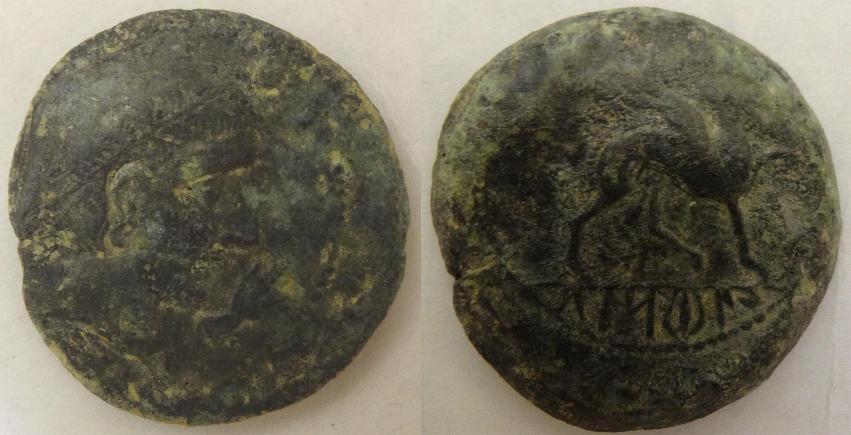
This bronze coin was minted around 120BC. The obverse has a diademed male head facing right. The reberse has a helmeted sphinx walking right with the Celtiberian 'KASTILO' below. The coin measures 29mm.
EGYPT ca 117BC
Ptolemy IX Soter II was king of Egypt three times, from 116BC to 110BC, 109BC to 107BC and 88BC to 81BC, with intervening periods ruled by his brother, Ptolemy X Alexander. At first he was chosen by his mother Cleopatra III to be her co-regent (his father Ptolemy VIII wished that she would rule with one of her sons), though she was more forced to choose him by the Alexandrians. He married his sister Cleopatra IV, but his mother pushed her out and replaced her with his younger sister Cleopatra Selene. Later, she claimed that he tried to kill her, and successfully deposed him, putting her favorite son Alexander on the throne as co-regent with her. However, she later grew tired of the now Ptolemy X and deposed him, putting Ptolemy IX back on the throne. She was soon murdered by Ptolemy X, who took the throne again. He was then killed in battle, and Ptolemy IX reigned until his own death. In Alexandria, Ptolemy IX replaced the gold sarcophagus of Alexander the Great with a crystal or glass one, and melted the original down in order to strike emergency gold issues of his coinage. The citizens of Alexandria were outraged at this and soon after, Ptolemy IX was killed.
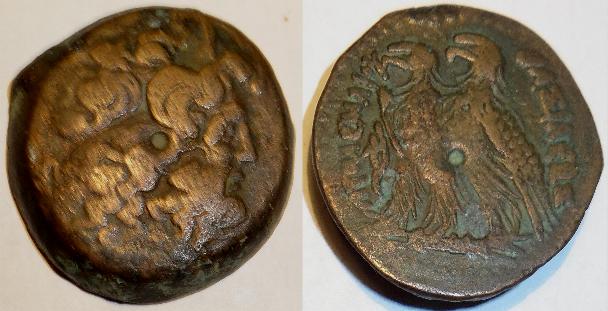
This large bronze coin was minted under Ptolemy IX from
117-81BC. The obverse has a diademed head of Zeus Ammon facing right. The
reverse has two eagles standing on thunderbolt. There is a winged thunderbolt on
the left field. All encircled by the Greek legend PTOLEMAIOU
BASILEWS. The coin measures 29mm. Most of these coins have the
circular indentation on the center of both sides. Speculation is that they were
created during the preparation of the flan for striking. Likely a tool was used
to hold the flan in place as it was rotated in a circular motion to make it
easier to shave the edges of the planchet to the right dimensions.
This is a tetradrachm issued by Ptolemy XII in 62/1BC (Regnal Year 20). The obverse has a diademed head of Ptolemy XII facing right with an aegis at neck. The reverse has a standing eagle on a thunderbolt with the Greek legend PTOLEMAIOU BASILEWS, with IK (date) before, PA (Paphos Cyprus mint) behind.
MESEMBRIA, PONTUS - ca 110BC
Mesembria was a colony of Pontus at this time located on the western coast of the Black Sea in today's Bulgaria. It was an ancient Greek settlement that was taken by Mithradates VI, king of Pontus.
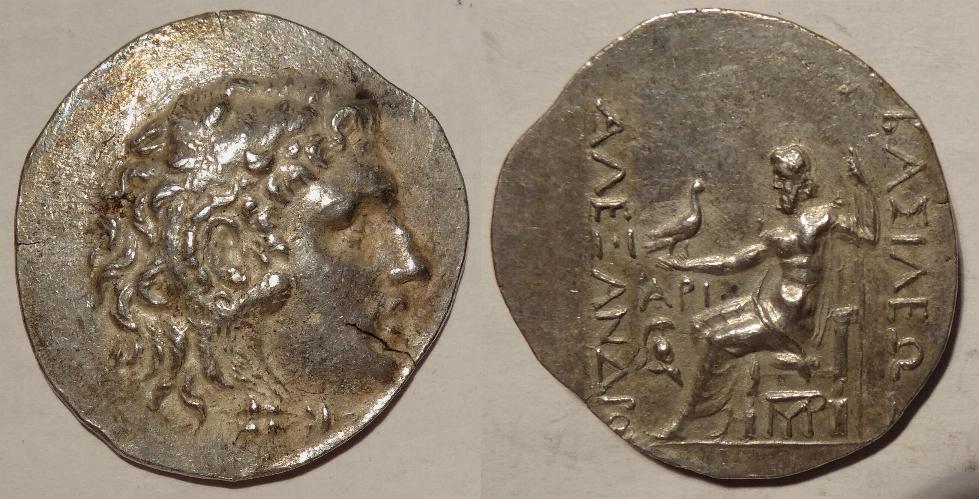
This silver tetradrachm has a head of Apollo (some believe with
the face of Alexander the Great). The reverse has a seated Zeus with a bird on
his right arm. The legs are crossed with indicates it is a posthumous issue).
The legend to the right is ΒΑΣΙΛΕΥΣ
and to the left
ΑΛΕΞΑΝΔΡΟΥ.
Under the arm are the letters
API and a monogram of a Corinthian helmet. A monogram of MP is under the
seat. The coin measures 33mm and weighs 17 grams. The coin was issued under Mithradates
VI (ca. 120-63BC) and struck around 110-90BC. This coin is in exceptional condition.
MYNDOS ca 100BC
Myndos was an ancient Dorian colony of Troezen, on the coast of Caria in Asia Minor sited on the Bodrum Peninsula, a few miles northwest of Halicarnassus. The site is now occupied by the modern village of Gümüslük, Turkey.
.
This is silver hemidrachma (half drachm) issued in Mynos around 100BC. The obverse has an image of Dionysos' head wreathed with ivy facing right. The reverse has a winged thunderbolt with ΜΥΝΔΙΩΝ (the city's name) and ΑΛΕΞΑΔΡΟΥ (apparently the issuing magistrate) below. It measures 15mm and weighs about 2 grams.
INDO-SCYTHIA - ca 35BC
Indo-Scythian rule in northwestern India ended with the last Western Satrap Rudrasimha III in AD 395.
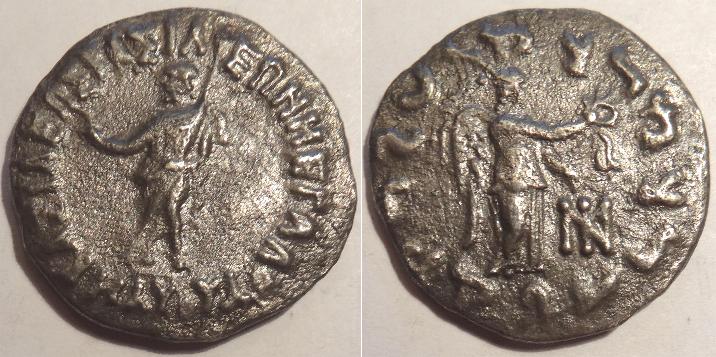
This is a silver tetradrachm issued by Maues around 100BC. The obverse has Zeus standing left in himation, carrying three-pronged scepter with arm extended left, Greek legend Maues, Great King of Kings around. The reverse has Nike standing right, palm with streamers over shoulder, right arm extended holding wreath, monogram below right with Kharosthi legend. The coin measures 26mm.
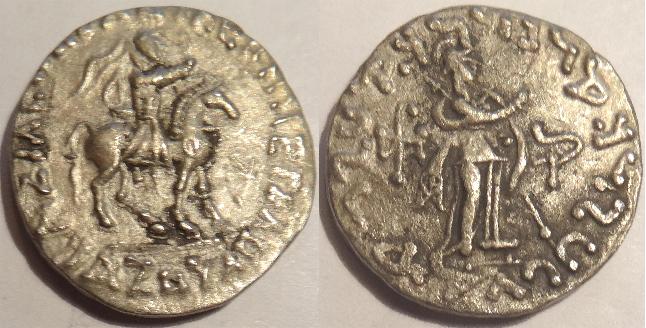
This is a silver tetradrachm issued by Azes II ariound 35BC-5AD. The obverse has the king on horseback facing right with his title BASILEWS BASILEWN MEGALOU AZOU. The reverse has Pallas Athena standing right, right arm extended, spear and shield in left. Monograms to left and right with Karosthi legend. the coin mmeasures 22m.
Cappodocia is a historical region in central Anatolia, largely in Nevsehir Province, in today's Turkey. After bringing the Persian Empire to an end, Alexander the Great tried to rule the area through one of his military commanders. But Ariarathes, a Persian aristocrat, somehow became king of the Cappadocians. Ariarathes I (332–322BC) was a successful ruler, and he extended the borders of the Cappadocian Kingdom as far as to the Black Sea. After the death of Alexander the previous empire was then divided into many parts, and Cappadocia fell to Eumenes. His claims were made good in 322BC by the regent Perdiccas, who crucified Ariarathes, In the dissensions which brought about Eumenes's death, the son of Ariarathes recovered his inheritance and left it to a line of successors, who mostly bore the name of the founder of the dynasty. Cappadocia entered into an alliance with Rome, first as a foe espousing the cause of Antiochus the Great, then as an ally against Perseus of Macedon. The kings henceforward threw in their lot with the Republic as against the Seleucids, to whom they had been from time to time tributary. The Cappadocians, supported by Rome against Mithridates VI of Pontus, elected a native lord, Ariobarzanes, to succeed (93BC); but in the same year Armenian troops under Tigranes the Great entered Cappadocia, dethroned king Ariobarzanes and crowned Gordios as the new client-king of Cappadocia, thus creating a buffer zone against the encroaching Romans. It was not until Rome had deposed the Pontic and Armenian kings that the rule of Ariobarzanes was reestablished (63BC).
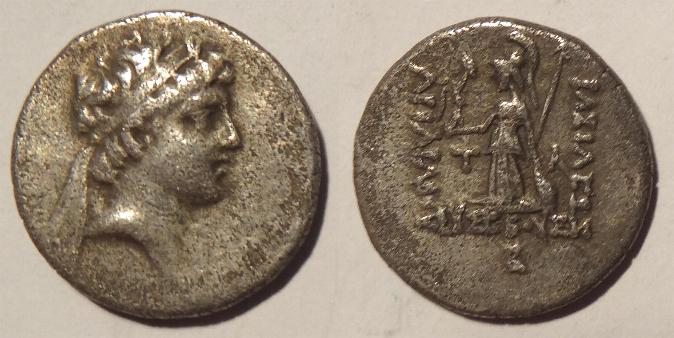
This is a silver drachm of Ariarathes VII Philometor of 96/95BC, The obverse has a young head of the king facing right. The reverse has Athena standing left holding Victory, a spear and a shield. The Greek legend is BASILEWS ARIARAQOU FILOMETOS . The regal year K is at the bottom. The coin measures 17mm.
Seleukid KINGDOM - 93BC
The Seleucid Empire was a Hellenistic state ruled by the Seleucid dynasty founded by Seleucus I Nicator following the division of the empire created by Alexander the Great. Seleucus received Babylonia and, from there, expanded his dominions to include much of Alexander's near eastern territories. At the height of its power, it included central Anatolia, the Levant, Mesopotamia, Kuwait, Persia, Afghanistan, Turkmenistan, and northwest parts of India. Much of the eastern part of the empire was conquered by the Parthians under Mithridates I of Parthia in the mid-2nd century BC, yet the Seleucid kings continued to rule a rump state from Syria until the invasion by Armenian king Tigranes the Great and their ultimate overthrow by the Roman general Pompey. By 100BC, the once formidable Seleucid Empire encompassed little more than Antioch and some Syrian cities. In the wars in Anatolia between Mithridates VI of Pontus and Sulla of Rome, the Seleucids were largely left alone by both major combatants. Mithridates' ambitious son-in-law, Tigranes the Great, king of Armenia, however, saw opportunity for expansion in the constant civil strife to the south. In 83BC, at the invitation of one of the factions in the interminable civil wars, he invaded Syria, and soon established himself as ruler of Syria, bringing the Seleucid Empire virtually at an end. Following the Roman general Lucullus' defeat of both Mithridates and Tigranes in 69BC, a rump Seleucid kingdom was restored under Antiochus XIII. Even so, civil wars could not be prevented, as another Seleucid, Philip II, contested rule with Antiochus. After the Roman conquest of Pontus, the Romans became increasingly alarmed at the constant source of instability in Syria under the Seleucids. Once Mithridates was defeated by Pompey in 63BC, Pompey set about the task of remaking the Hellenistic East by creating new client kingdoms and establishing provinces. While client nations like Armenia and Judea were allowed to continue with some degree of autonomy under local kings, Pompey saw the Seleucids as too troublesome to continue. He then did away with both rival Seleucid princes, and made Syria into a Roman province.
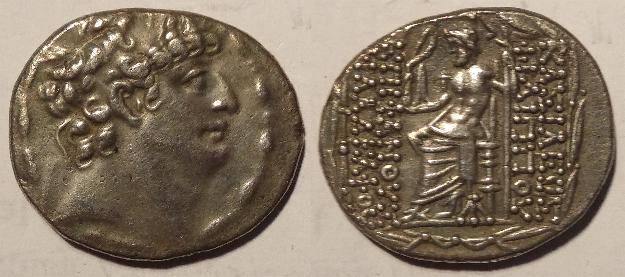
This silver tetradrachm of Philip II was minted from 93-83BC. The obverse has a diademed bust facing right with a filleted border. The reverse has the Greek legend BASILEWS FILIPPOU EPIFANOUS FILADELFOU lettered in dots with Zeus seated facing left, holding Nike. The coin measures 27mm.
AMISOS ca 86BC
Amisos is located on the northeastern Black Sea coast of Turkey. The early Greek historian Hecataeus wrote that Amisos was formerly called Enete, the place mentioned in Homer's Iliad. It has also been known as Peiraieos by Athenian settlers and even briefly as Pompeiopolis by a Roman Emperor who wanted it named after him. Amisos was settled between the years of 760-750BC by people from Miletos, who established a flourishing trade relationship with the ancient peoples of Anatolia. The city's ideal combination of fertile ground and shallow waters attracted numerous traders. The city was captured by the Persians in 550BC and became part of Cappadocia (satrapy). In the 4th century BC the city came under the expanded rule of the Kingdom of Pontus. The Romans took over in 71BC and Amisos became part of Bithynia et Pontus province (and later Dioecesis Pontica) of the eastern Roman Empire.
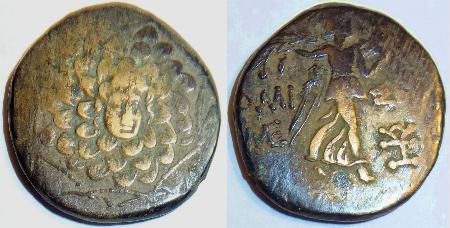
This brass coin was minted in 85-65BC. The obverse has a figue of Aegis (a protective ornament used on armor) with Gorgon's head (a dreadful looking female creature) in the center. The reverse has Nike advancing right carrying a palm branch with monograms left and right. AMI-SOU brackets Nike. The coin measures 21mm.
Termessos Major, Pisidia ca 71BC
Termessos was a Pisidian city built at an altitude of about 4,000 feet at the south-west side of the mountain Solymos in the Taurus Mountains. The ancient city was founded by the Solims who lived in the Psidia Region. Although there are no facts available about Termessos and Solims, they are referenced by Homer in the Iliad in connection with the legend of Belleropho. Pisidia was an inland region of ancient Asia Minor, located north of Lykia, and bordering Karia, Lydia, Phrygia and Pamphylia. Pisidia was a wild, mountainous region, and one of the most difficult for outside powers to control. It was largely independent from both the Lydians and the Persians. Alexander the Great had somewhat better luck, although the city of Termessos defied him, but the Hellenistic kings were never in full control. Cities in the region was among the last in western Anatolia to Hellenize and to coin their own money.
This bronze coin was minted in 71-36BC. The obverse features a
bust of Zeus facing right. The reverse has a horse with rider galloping
right. There is a Greek legend ΤΕΡ
TYRE, PHOENICIA ca 55BC
Tyre, Phoenicia was founded around 2750 BC according to Herodotus and was originally built as a walled city upon the mainland. Its name appears on monuments as early as 1300 BC. Tyrian merchants were the first who ventured to sail the Mediterranean. They founded colonies on the coasts and neighbouring islands of the Aegean Sea, in Greece, on the northern coast of Africa at Carthage and many other places such as Sicily, Corsica, and Spain. In 332BC Alexander the Great laid siege to the city, conquered and razed it. It became a Roman province in 64BC.
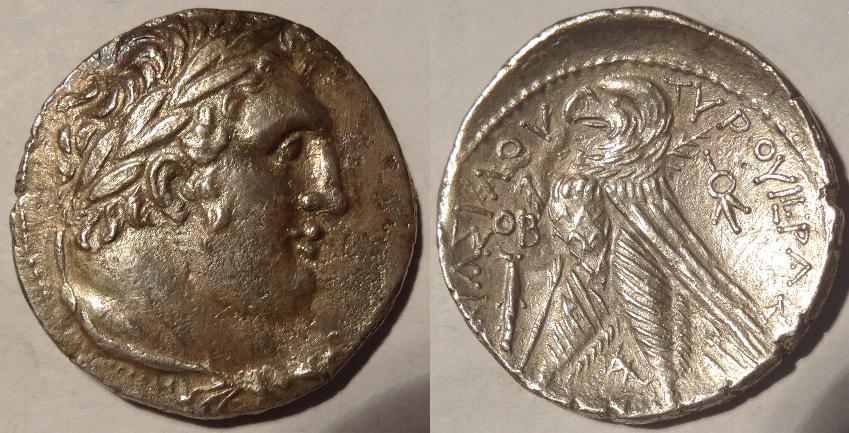
This is a silver shekel minted in Tyre in 55BC. The obverse has
the laurate head of the god Melqarth. The reverse has a standing eagle facing
left with the legend ΤΥΡΟΥ
ΙΕΡΑΣ
ΚΑΙΑΣΙΛΟΥ (Of
Tyre Sacred and Inviolate)
ROMAN
The history of Rome spans 2,800 years of the existence of a city that grew from a small Latin village in the 9th century BC into the centre of a vast civilisation that dominated the Mediterranean region for centuries. The population of the city fell drastically in the Late Empire after Rome ceased to be the capital of the Empire.
According to the founding myth of Rome, the city was founded on 21 April 753BC by twin brothers Romulus and Remus, who were descended from the Trojan prince Aeneas and who were grandsons of the Latin King Numitor of Alba Longa. King Numitor was deposed from his throne by his brother, Amulius, while Numitor's daughter, Rhea Silvia, gave birth to the twins. Because Rhea Silvia was raped and impregnated by Mars, the Roman god of war, the twins were considered half-divine. The new king feared Romulus and Remus would take back the throne, so he ordered them to be drowned. A she-wolf saved and raised them, and when they were old enough, they returned the throne of Alba Longa to Numitor.
The twins then founded their own city, but Romulus killed Remus in a quarrel over the location of the Roman Kingdom, though some sources state the quarrel was about who was going to rule or give his name to the city. Romulus became the source of the city's name. In order to attract people to the city, Rome became a sanctuary for the indigent, exiled, and unwanted. This caused a problem for Rome, which had a large workforce but was bereft of women. Romulus traveled to the neighboring towns and tribes and attempted to secure marriage rights but as Rome was so full of undesirables they all refused. Legend says that the Latins invited the Sabines to a festival and stole their unmarried maidens, leading to the integration of the Latins and the Sabines.
According to tradition and later writers such as Livy, the Roman Republic was established around 509BC, when the last of the seven kings of Rome, Tarquin the Proud, was deposed by Lucius Junius Brutus, and a system based on annually elected magistrates and various representative assemblies was established. A constitution set a series of checks and balances and a separation of powers. The most important magistrates were the two consuls, who together exercised executive authority as imperium, or military command. The consuls had to work with the senate, which was initially an advisory council of the ranking nobility, or patricians, but grew in size and power.
In the mid-1st century BC, Roman politics were restless. Political divisions in Rome became identified with two groupings, populares (who hoped for the support of the people) and optimates (the "best", who wanted to maintain exclusive aristocratic control. Sulla overthrew all populist leaders and his constitutional reforms removed powers (such as those of the tribune of the plebs) that had supported populist approaches. Meanwhile social and economic stresses continued to build. Rome had become a metropolis with a super-rich aristocracy, debt-ridden aspirants, and a large proletariat often of impoverished farmers. The latter groups supported the Catilinarian conspiracy – a resounding failure, since the consul Marcus Tullius Cicero quickly arrested and executed the main leaders of the conspiracy.
Onto this turbulent scene emerged Gaius Julius Caesar, from a very aristocratic family of limited wealth. To achieve power, Caesar reconciled the two most powerful men in Rome, Marcus Licinius Crassus, who had financed much of his earlier career, and Crassus' rival, Gnaeus Pompeius Magnus (anglicized as Pompey), to whom he married his daughter. He formed them into a new informal alliance including himself, the First Triumvirate ("three men"). In 53BC, Crassus invaded Parthia and was killed in the Battle of Carrhae. The Triumvirate disintegrated at Crassus' death. Crassus had acted as mediator between Caesar and Pompey, and, without him, the two generals manoeuvred against each other for power. Caesar conquered Gaul, obtaining immense wealth, respect in Rome and the loyalty of battle-hardened legions. He also became a clear menace to Pompey and was loathed by many optimates. Confident that Caesar could be stopped by legal means, Pompey's party tried to strip Caesar of his legions, a prelude to Caesar's trial, impoverishment, and exile.
To avoid this fate, Caesar crossed the Rubicon River and invaded Rome in 49BC. Pompey and his party fled from Italy, pursued by Caesar. The Battle of Pharsalus was a brilliant victory for Caesar and in this and other campaigns he destroyed all of the optimates' leaders, Metellus Scipio, Cato the Younger, and Pompey's son, Gnaeus Pompeius. Pompey was murdered in Egypt in 48BC. Caesar was now pre-eminent over Rome, attracting the bitter enmity of many aristocrats. He was assassinated in 44BC, on the Ides of March by the Liberatores.
Caesar's assassination caused political and social turmoil in Rome. Without the dictator's leadership, the city was ruled by his friend and colleague, Mark Antony. Soon afterward, Octavius, whom Caesar adopted through his will, arrived in Rome. Octavian tried to align himself with the Caesarian faction. In 43BC, along with Antony and Marcus Aemilius Lepidus, Caesar's best friend, he legally established the Second Triumvirate. This alliance would last for five years.
In 27BC, Octavian was the sole Roman leader. His leadership brought the zenith of the Roman civilization, that lasted for two centuries. In that year, he took the name Augustus. That event is usually taken by historians as the beginning of Roman Empire – although Rome was an "imperial" state since 146BC, when Carthage was razed by Scipio Aemilianus and Greece was conquered by Lucius Mummius. Officially, the government was republican, but Augustus assumed absolute powers.
Octavian was followed by a number of emperors who ruled over the empire. There were many murders done by those competing for the office of emperor. There were pretender emperors usually in the field who claimed the title emperor.
The Roman monetray system was based upon the silver denarius.
During the Republic, the denarius was equal to 4 of the copper sestertius; 5 of the copper dupondius;10 of the copper as; 20 of the copper semis; 24 of the copper quincunx; 30 of the copper triens; 40 of the copper quadrans; or 120 of the copper uncia. Note: some of the copper coins were also minted in brass. These were the coins used in Rome at first, then at other mints in Italy. After they occupied former Greek and other cities, different denominations were used to fit the local customs.
Augustus added two gold denomnations, the aureus and the quinarius aureus as well as a silver quinarius argenteus (half denarius).
Later the gold coin became the solidus.
In the mid-200s, the denarius was dropped and replaced by the antoninianus originally as a silver coin representing two denarii but containing the silver of one and a half denarii. It quickly morphed into a billon coin usually washed with silver. Later the follis was issued which is a fairly large and heavy bronze coin. Even later smaller bronze coins were issued and their names are unknown so they are simply called AE4, AE3, etc. The number denotes the size range: AE2, which is 21-25mm, AE3, which is 17-21mm, and AE4, which is smaller than 17mm.
Common reference books on these series are:
- ROMAN COINS AND THEIR VALUES by David R. Sear (several editions, the current being the 2002 series of two volumes printed by Spink in London}
- THE ROMAN IMPERIAL COINAGE by Spink (a multi-volume set)
- ROMAN SILVER COINS AND THEIR VALUES by David R. Sear (a multi-ccolume set)
- GREEK IMPERIAL: COINS AND THEIR VALUES by David L. Sear (covers Roman coins issued in formerly Greek-controlled areas)
The coins are presented in chronological order.
ROMAN REPUBLIC
In Republican Rome, the treasury was under the authority of the quaestors. In the 1st century BC (and perhaps earlier), a board of junior magistrates (moneyers) are known to have been responsible for the minting of coinage. This consisted of three men, the ‘triumviri auro argento aere flando feriundo’ (meaning ‘three men responsible for casting and striking gold, silver and bronze’), referred to on coins with the abbreviation IIIVIR. A. A. A. F. F., or more usually just IIIVIR for triumvir. Their number was increased to four under Caesar. Other magistrates, such as quaestors and curule aediles, are also known to have issued coins.
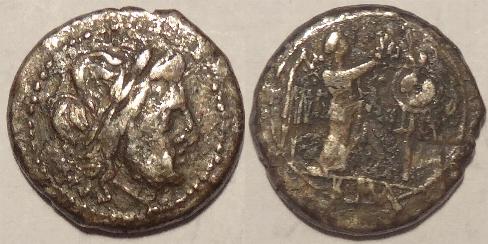
This silver victoriatus was issued by an anonymous moneyer in 209BC. The obverse has a laureate head of Jupiter facing right. The reverse has Victory standing right, erecting trophy, spearhead upward in field, with ROMA in the exergue. The coin measures 13mm.

This silver denarius was issued by an anonymous moneyer in 175-172BC. The obverse has a winged helmeted head of Roma facing right with X behind and a staff right. The reverse has the Dioscouroi riding right holding spears with a wheat sheath below and ROMA in the exergue. The coin measures 16mm.
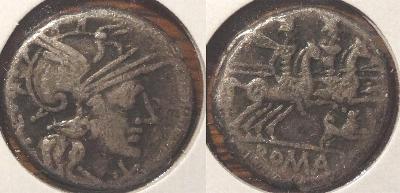
This silver denarius was issued by the moneyer C. Anestius in 145BC. The obverse has a helmeted head of Roma facing right, with an X below the chin and the moneyer's name C ANTESTI behind the head (nostly off the planchet). The reverse has Dioscuri galloping, with a dog leaping right with both fore paws off the ground below the horses with ROMA is in the exergue. The coin measures 17mm.
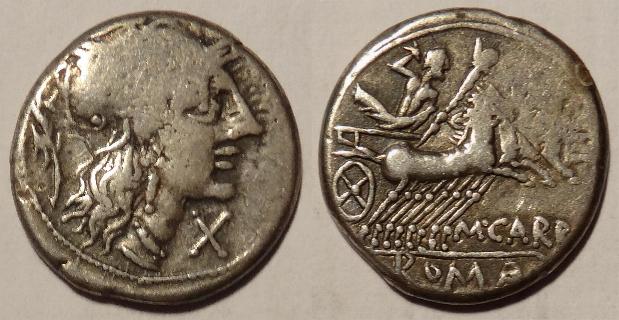
This silver denarius was issued by the moneyer M. Papirius Carbo in 122BC. The obverse has a helmeted head of Roma facing right, with a laurel branch behind, and an X below the chin. The reverse has Jupiter driving a quadriga to the right holding a thunderbolt with an eagle- tipped scepter, M CARBO is below the horses, and ROMA is in the exergue. The coin measures 17mm.
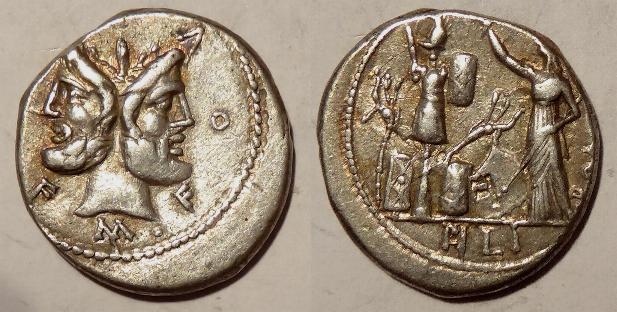
This silver denarius was issued by the moneyer M. Furius Philus in 119BC. The obverse has a aureate head of Janus with M•FOVRI•L•F around. The reverse has Roma standing left erecting a trophy with Gallic arms around and, ROMA to right (almost off the planchet) and PHLI in the exerge. The coin measures 18mm.
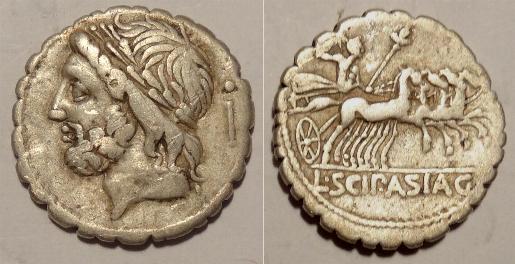
This silver denarius was issued by the moneyer L. Cornelius Scipio Asiaticus in 106BC. The obverse has a laureate head of Jupiter facing left, a dot above the letter I behind head. The reverse has Jupiter driving a quadriga to the right holding a thunderbolt with a scepter with L-SCIP-ASIAC is below the horses. The coin measures 18mm. This coin has a serrated edge.

This silver denarius was issued by the moneyer L. Calpurnius Piso Frugi in 90BC. The obverse has a laureate head of Apollo facing right. The reverse has a horseman galloping right, holding palm with a star above with L PISO FRVGI below. The coin measures 20mm.
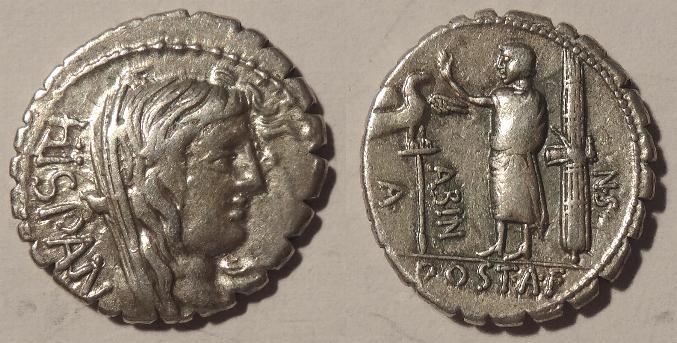
This silver denarius was issued by the moneyer A. Postumius Albinus in 81BC. The obverse has the legend HISPAN and veiled head of Hispania. The reverse has A ALBIN - S N, a togate figure standing left between legionary eagle and fasces with POST A F in the exergue. The coin measures 19mm. This coin has a serrated edge
. 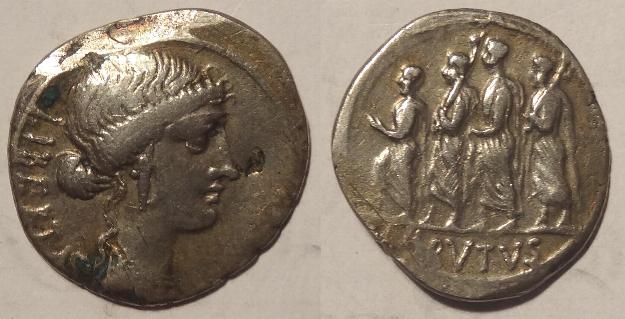
This silver denarius was issued by the moneyer M. Junius Brutus in 54BC. The obverse has LIBERTAS behind head of Liberty facing right.It is lightly stroked peripherally (ancient strike). There is a countermark of emperor Claudius on the obverse. The reverse has the consul L. Junius Brutus walking left between two lictors preceded by an accensus with BRVTVS in exergue. The coin measures 20mm.
IMPERIAL ROME - The 12 Caesars
Typically Roman Imperial coins have a depiction of the emperor (or other official) on the obverse and gods, soldiers, monuments, and special commemorative events on the reverse.
The obverse also includes an abbreviated title of the emperor/official with his name. Remember that J and U on Roman coins are shown in Latin as I and V. Here are the common abbreviations of found in titles:
AVG - AVGVSTVS: Emperor
AVGG - Co-emperor
CAES, CAE, C - CAESAR - Title used similar to Tsar, it is
from Julius Caesar
CENS P, CENS PERP - Perpetual censor
COS, CONS, CO, C - CONSVL - Consul (an
honorary title after a Republic office)
DN - DOMINUS NOSTER - Our Lord
FEL - FELIX - Happy
IMP - IMPERATOR - Emperor
NC, NOB C, NOB CAES - A junior official, ofter a
son
P - PIUS - Pious
PM, PONT MAX - PONTIFEX MAXIMVS - Highest priest
(the title is used by the Roman Catholic Pope today)
PP - PATER PATRIAE - Father of the country
TRP, TRIB POT, P - TRIBVNICIA POTESTAS -
Power of the tribune
There are other titles assigned the victorious emperors after defeat and
annexation of an area. They include DAC (Dacians - Romanians), GERM (Germans),
PAR (Parthia - Ira, Afghanistan).
The reverse depicts gods, soldiers, memorials, events, and so
on. They are identified by the coin's reverse legend. Some of the more common
ones are CONCORDIA MILITVM - Concord soldiers
FEL TEMP REPARATIO - Renewal of war time
FORTVNAE FELICI - Good luck and happy
GENIO - Genius. Used with other modifiers:
GLORIA ROMANORVM - the glory of the Romans
HOC SIGNO VICTOR ERIS - With this sign you will be the victor
(the Christian Chi-Rho symbol)
IOVI CONSERVATORI - Jupiter the keeper
NOBILITAS - Celebrity
REPARATIO REIPVB - Restoration of the republic
RESTITV-TOR REIP and RESTITVTOR-REIPVBLICAE - Restored republic
SALVS REIPVBLICAEAE - The safety of the republic
SC - Consultation with the Senate
SECVRITAS REIPVB - Security of the republic
SOLI INVICTO COMITI - Unconquered sun companion
SPES REIPVBLICE - Hope of the republic
SPQR - The Senate and the People of Rome
VENERI FELICI - Happy Vemus
VIRTVTI EXERC - The Courage of the Army
You can access any particular emperor/usurper:
ANTONINUS PIUS Click Here
AUGUSTUS Click Here
AURELIAN Click Here
CARACALLA Click Here
CARINUS Click Here
CARUS Click Here
CLAUDIUS Click Here
CLAUDIUS GOTHICUS Click Here
COMMODUS Click Here
CONSTANS I Click Here
CONSTANTINE I Click Here
CONSTANTINE II Click Here
CONSTANTIUS I Click Here
CRISPUS Click Here
DIOCLETIAN Click Here
DOMITIAN Click Here
ELAGABALUS Click Here
FLORIAN Click Here
GALERIUS Click Here
GETA Click Here
GORDIAN III Click Here
HADRIAN Click Here
JULIAN II Click Here
JULIUS CAESAR Click Here
LICINIUS I Click Here
LICINIUS II Click Here
MARC ANTONY (not an emperor but an important historical
figure) Click Here
MARCUS AURELIUS Click Here
MAXIMIANUS Click Here
MAXIMINUS I Click Here
MAXIMINUS II Click Here
NERO Click Here
NERVA Click Here
PHILIP I Click Here
PROBUS Click Here
SEPTIMUS SERVUS Click Here
SEVERUS ALEXANDER Click Here
TACITUS Click Here
THEODOSIUS I Click Here
TIBERIAS Click Here
TITUS Click Here
TRAJAN Click Here
TRAJAN DECIUS Click Here
VALENTINIAN I Click Here
VALERIAN I Click Here
VESPASIAN Click Here
VITELLIUS Click Here
Wives of emperors:
Faustina Major Click Here
Faustina Minor Click Here
Julia Domna Click Here
Julia Maesa Click Here
Julia Mamaea Click Here
Marcia Otacilia Severa Click Here
Salonina Click Here
Ulpia Severina Click Here
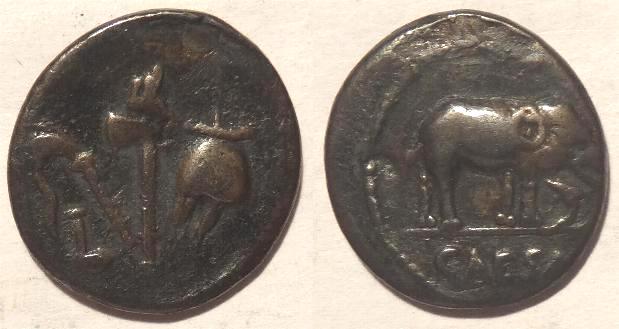
JULIUS CAESAR
This silver denarius was issued in 49/48BC by Julius Caesar, The obverse has pontifical instruments - simpulum, sprinkler, axe and priest's hat. The reverse has an elephant right, trampling on serpent with CAESAR in the exergue, The coin measures 18mm.
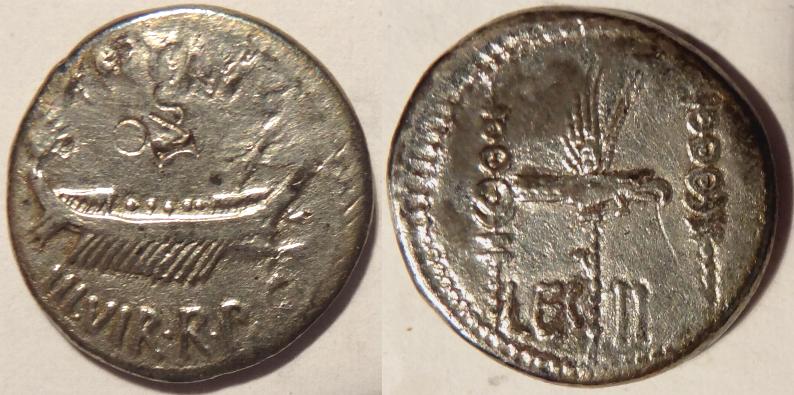
MARC ANTONY
This is a silver Marc Antony Legionary Denarius minted 32-31BC. The obverse has a Praetorian galley with ANT AVG above and III VIR R P C below with thyrsos behind the prow. The reverse has LEG II with eagle between standards. There are some counterstamps on the obverse. This coin measures 16mm.
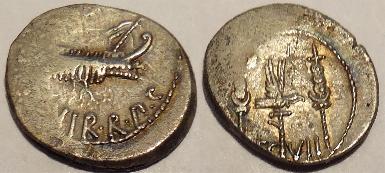
This is a silver Marc Antony Legionary Denarius minted 32-31 BC. The obverse has a Praetorian galley with ANT AVG above and III VIR R P C below with thyrsos behind the prow. The reverse has LEG VII with eagle between standards. This coin measures 17mm. This coin was struck off center.
Julio-Claudian Dynasty
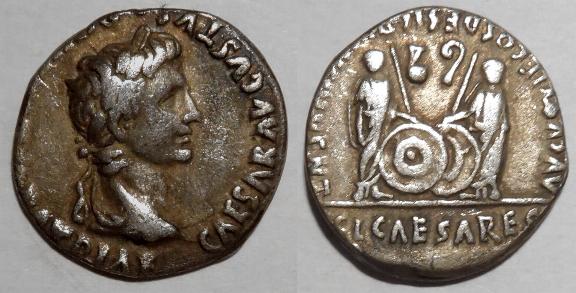
AUGUSTUS (January 16, 27BC – August 19, 14AD)
This is a silver denarius minted by Augustus (formerly Octavian) in 27BC or later. The obverse has a laureate head facing right encircled by CAESAR AVGVSTVS DIVI F PATER PATRIAE. The reverse has Gaius and Lucius standing with shields and spears in front with priestly implements, a lituus left and simpulum right facing outwards. The coin measures 19mm.
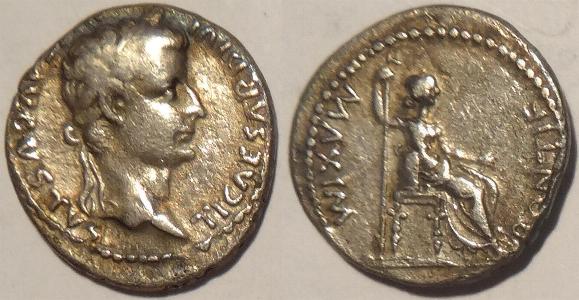
TIBERIAS (September 18, 14AD – March 16, 37AD)
This is a silver denarius minted by Tiberias around 14-37AD. The obverse has his laureated head facing right with the title TI CAESAR DIVI AVG F AVGVSTVS. The reverse has his mother Livia seated facing right with the legend PONTIF MAXIM. The coin measures 20mm. This is believed to be the Tribute Penny mentioned in the New Testament.
CLAUDIUS (January 25/26, 41AD – October 13, 54AD)
This bronze coin was issued by Claudius around 41-54AD. The obverse has his bust facing left with the legend TI CLAVDIVS CAESAR P M TR P IMP. The reverse has Liberty standing facing right with LIBERTAS AUGUSTA with S C (Sentus Consultus) on sides The coin measures 28mm.
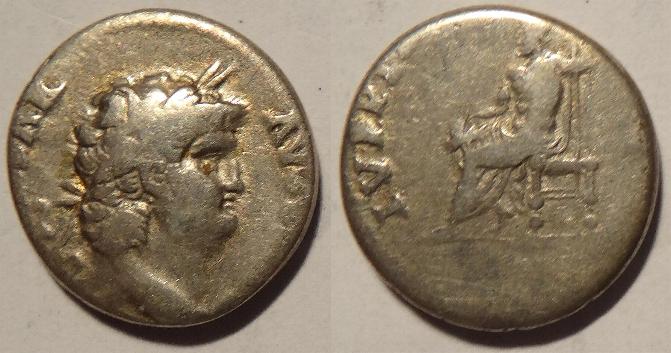
NERO (October 13, 54AD – June 9, 68AD)
This is a silver denarius minted by Nero from 66/7AD. The obverse has his laureate bust facing right with the title IMP NERO CAESAR AVGVSTVS. The reverse has an image of a seated Jupiter facing left holding a thunderbolt and scepter with the legend IVPPITER CVSTOS. The coin measures 15mm.
Flavian Dynasty
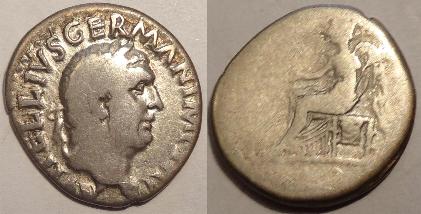
Vitellius (April 17, 69AD – December 20, 69AD)
This is a silver denarius minted by Vitellius in 69AD. The obverse has his laureate head right with his title A VITELLIVS GERMAN IMP TR P. The reverse has Vesta seated facing left holding a patera and torch. The legend VESTA P R QVIRITIVM is worn off the coin. This coin measures 18mm.
The year 69 had four different emperors each ruling for only a few months except for Vespasian. Two were murdered and one committed suicide after a battle loss. Coins of Galba and Otho are quite scarce.
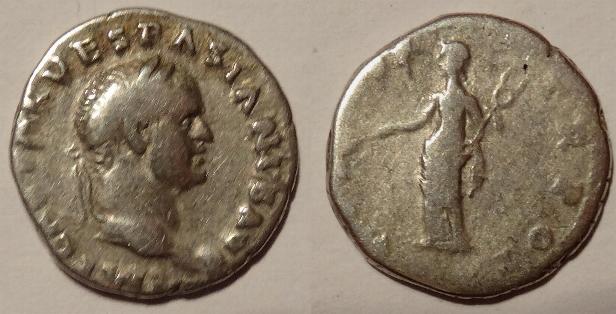
VESPASIAN (July 1, 69AD – June 24, 79AD)
This is a silver denarius minted by Vespasian in 70AD. The obverse features a laureate head facing right with the title IMP CAESAR VESPASIANVS AVG. The reverse has Pax standing left with branch and a caduceuswith the legend COS ITER TR POT. The coin measures 19mm.
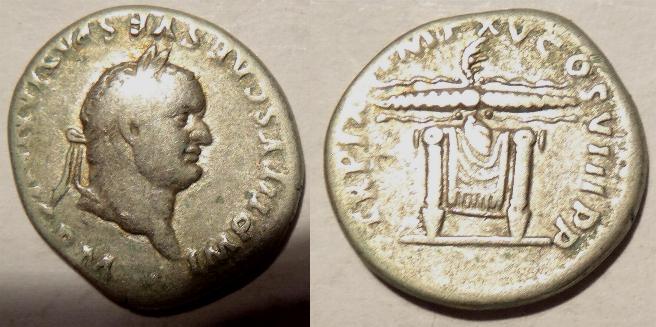
TITUS (June 24, 79AD – September 13, 81AD)
This is a silver denarius minted by Titus in 80AD. The obverse has his laureated head facing right with his title IMP.TITVS CAESVESPASIAN AVG.P M. The reverse has a winged thunderbolt on a throne with the legend TR.P.TR IMP XV COSVIII PP. The coin measures 17mm.
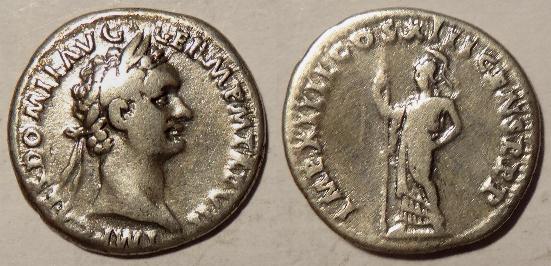
DOMITIAN (September 14, 81AD – September 18, 96AD)
This is a silver denarius minted by Domitian in 87AD. The obverse has a laureated head of Domitian facing right with his title IMP CAES DOMIT AVG GERM P M TR P VII . The reverse has Minerva standing facing left with the legend IMP XIIIICOS XIII CENS P P P. The coin measures 19mm.
Nervan-Antonian Dynasty
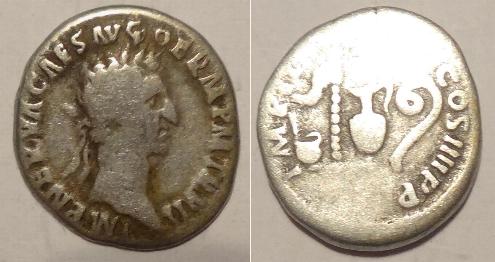
NERVA (September 18, 96AD – January 27, 98AD)
This is a silver denarius minted by Nerva in 98AD. The obverse has his laureated bust facing right with his title IMP NERVA CAES AUG GERM PM TRPII. The reverse has pontifical instruments, ladle, sprinkler, jug and lituus, with the legend IMP II COS IIII PP. The coin measures 18mm.
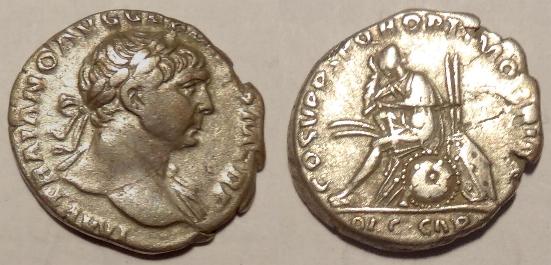
TRAJAN (January 28, 98AD – August 7, 117AD)
This is a silver denarius minted by Trajan around 104-111AD. The obverse has his laureate head facing right, drapery on far shoulder, with his title IMP TRAIANO AVG GER DAC P M TR P. The reverse has Dacia mourning, seated on a pile of captured arms with DAC CAP in exergue and the legend COS V P P SPQR OPTIMO PRINC. The coin measures 18mm.
This coins commemorates the victory over the Dacians. The conquest of Dacia was completed by Emperor Trajan in 106AD after two major campaigns against the Dacian kingdom. Dacia emcompassed much at what constitutes Romania today, The Romanian language a Romance language unlike most of the surrounding countries which retain Slavic languages (except for Hungary which uses a Finno-Ungric-Ural language).
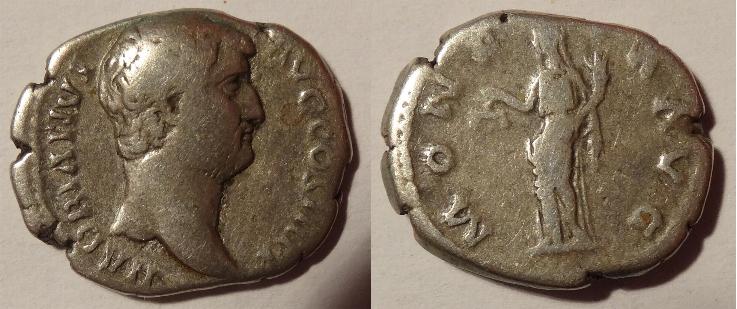
HADRIAN (August 11, 117AD – July 10, 138AD)
This is a silver denarius minted by Hadrian around 133AD. The obverse has a bare headed bust facing right with his title HADRIANVS AVG COS III P P. The reverse has Moneta standing facing right with scales and a cornucopia. It has the legend MONETA AVG. The coin measures 17mm.
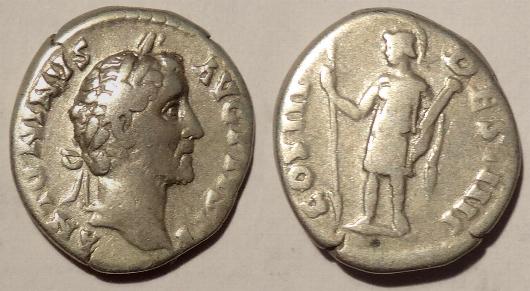
Antoninus Pius (July 10, 138AD – March 7, 161AD)
This is a silver denarius minted by Antoninus Pius around 144AD. The obverse has the laureate head facing right with his title ANTONINVS AVG PIVS P P. The reverse has Virtus holding a spear and a parazonium (long triangular dagger, wide at the hilt end and coming to a point) with the legend COS III DES IIII. The coin measures 18mm.
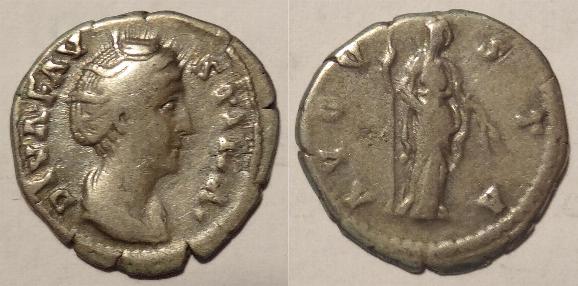
Faustina Major (wife of Antoninius Pius) (Died 141AD)
This is a silver denarius minted for Faustina Major around 142AD. The obverse has her bust facing with the title DIVA FAUSTINA. The reverse has Ceres standing with scepter and corn ears with the legend AVGVSTA. The coin measures 18mm.
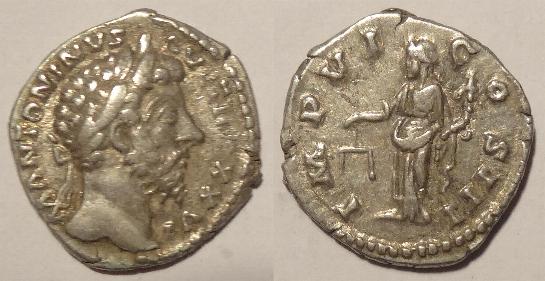
Marcus Aurelius (March 7, 161AD – March 17, 180AD)
This is a silver denarius minted by Marcus Aurelius around 171-2AD. The obverse has the laureate bust facing right with his title M ANTONIVS AVG TR P XXVI. The reverse has Aequitas standing to left holding scales and a cornucopia with the legend IMP VI COS III. The coin measures 18mm.
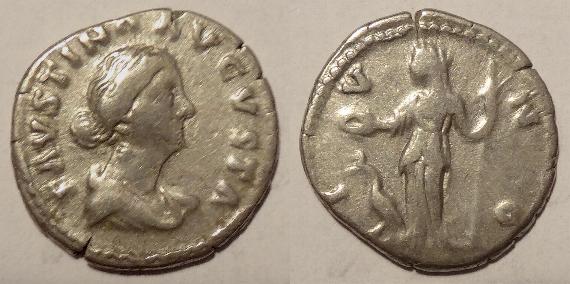
Faustina Minor (wife of Marcus Aurelius) (Died 175AD)
This is a silver denarius minted for Faustina Minor during her husband's reign. The obverse has her draped bust facing right with the title FAVSTINA AVGVSTA. The reverse has Juno standing to left holding a patera and scepter with a peacock left of her feet with the legend IVNO. The coin measures 19mm.
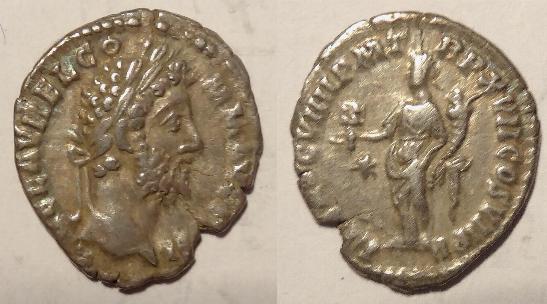
Commodus (177AD – December 31, 192AD)
This is a silver denarius minted by Commodus around 192AD. The obverse features the laureated bust facing right with his title L AEL AVREL COMM AVG P FEL. The reverse has Liberitas standing facing left holding an abacus and cornucopia with a star in the field and the legend LIB AVG VIIII P M TR P XVII COS VII PP. The coin measures 18mm.
Severan Dynasty
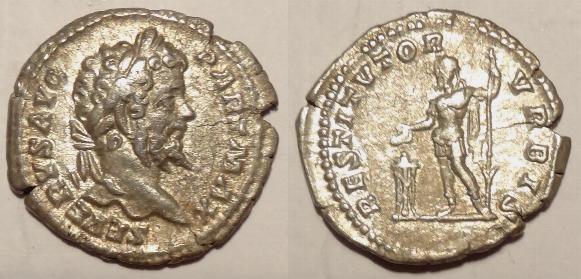
Septimus Severus (April 9, 193AD – February 4, 211AD)
This is a silver denarius minted by Septimus Severus around 200-1AD. The obverse has the lauraeted bust facing right with his title SEVERVS AVG PART MAX. The reverse has Septimius standing left, holding a patera in right hand over tripod altar with a spear in left with the legend RESISTVTOR VRBIS. The coin measures 18mm.
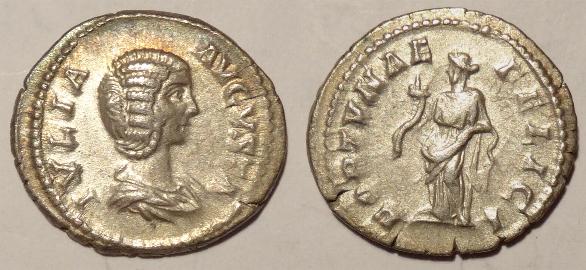
Julia Domna (wife of Septimius Severus)
This is a silver denarius issued for Julia Domna around 198-207AD. The obverse has a draped bust facing right with her title IVLIA AVGVSTA . The reverse has Fortuna standing left holding a cornucopia and leaning on a reversed rudder with the legend FORTVNAE FELICI. The coin measures 19mm.
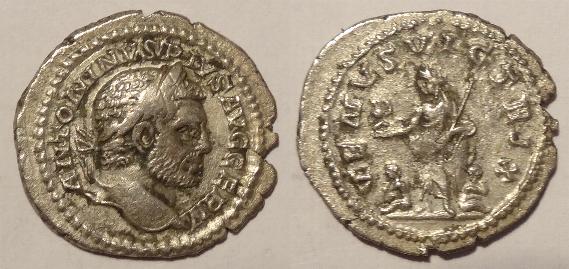
Caracalla (198AD – April 8, 217AD)
This is a silver denarius minted by Caracalla around 216AD. The obverse has a laureate bust facing right with his title ANTONINVS PIVS AVG GERM. The reverse has Venus standing left with Victory in her right hand, a spear in left hand, with captives on either side of her feet with the legend VENVS VICTRIX. The coin measures 21mm.
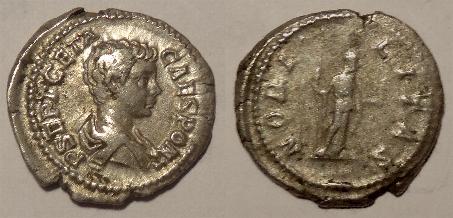
GETA (Caesar 198-209AD, Augustus 209AD – December 26, 211AD)
This is a silver denarius minted by Geta around 202AD. The obverse depicts Geta youth's bare headed and draped bust facing right with the title P SEPT GETA CAES PONT. The reverse depicts Nobilitas, standing half-right, holding a scepter and palladium with the legend NOBILITAS. The coin measures 20mm.
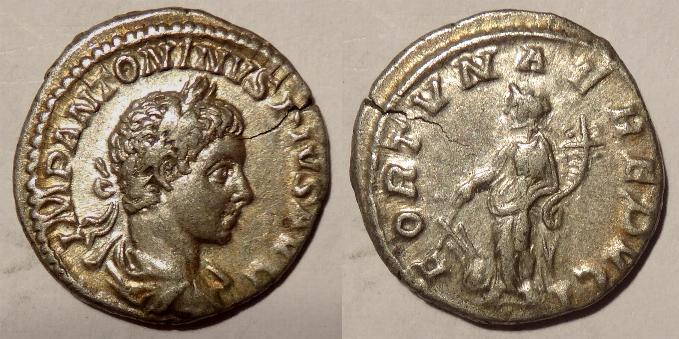
Elagabalus (June 8, 218AD – March 11, 222AD)
This is a silver denarius minted by Geta around 202AD. The obverse has the laureated head facing right with his title IMP ANTONINVS PIVS AVG. The reverse has Fortune standing left holding rudder on a globe and cornucopia with the legend FORTVNAE REDVCI. The coin measures 20mm.
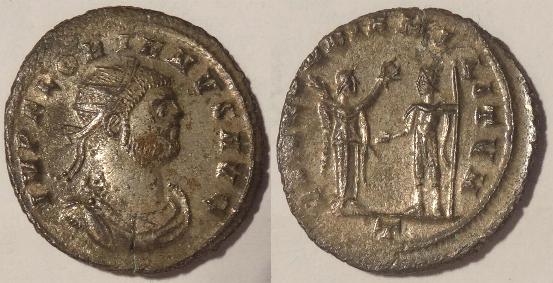
FLORIAN (JUNE 276 AD – SEPTEMBER 276 AD)
This is a silver antoninianus minted by Florian in 276. The obverse features the . radiate bust facing right with his title IMP FLORIANVS AVG .The reverse has Victory presenting wreath to the emperor with the legend CONCORDIA MILITVM It has the officina Mark T denoting its minting at Siscia
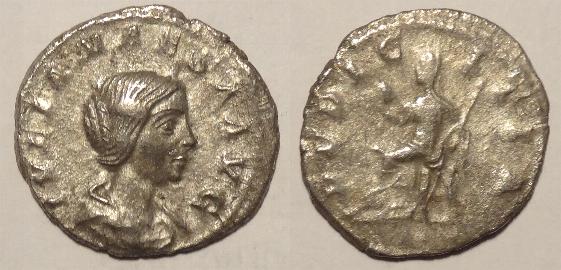
Julia Maesa (grandmother of Elagabalus) (Died 226AD)
This is a silver denarius issued for Julia Maesa around 198-207AD. The obverse has a draped bust with her title IVLIA MAESA AVG. The reverse has Pudicitia seated left raising a veil and holding scepter with the legend PVDICITIA. The coin measures 19mm.
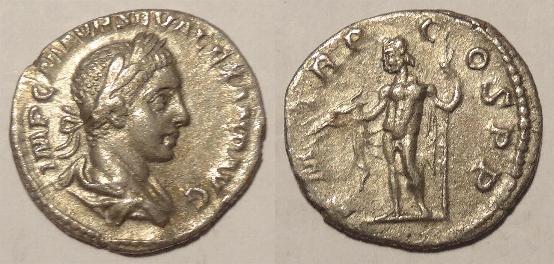
Severus Alexander (March 13, 222AD – March 18, 235AD)
This is a silver denarius minted by Severus Alexander in 222AD. The obverse has a laureated bust facing right with his title IMP C M AVR SEV ALEXAND AVG. The reverse has Jupiter standing nude facing left with a thunderbolt in hisw left hand and spear in other with the legend P M TRP - COS P P. The coin measures 17mm.
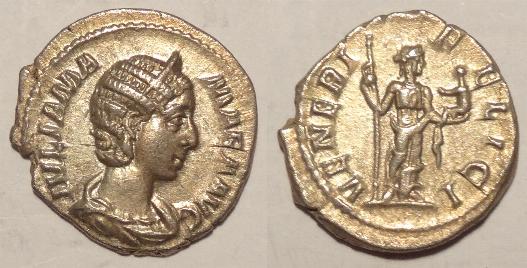
Julia Mamaea (Regent and Consort for and of Severus Alexander)
This is a silver denarius issued for Julia Mamaea around 222AD. The obverse has a diademed bust facing right with her title IVLIA MAMAEA AVG. The reverse has Venus standing facing right holding a scepter and Cupid with the legend VENERI FELICI. The coin measures 18mm.
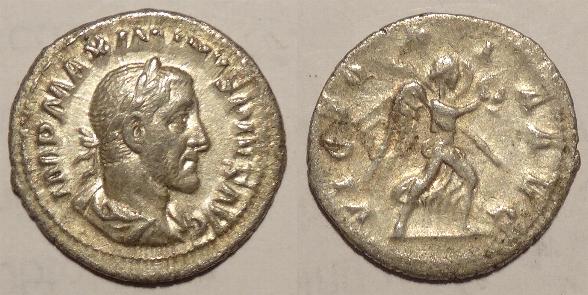
Maximinus I (March 20, 235AD – June 238AD)
This is a silver denarius minted by Maximinus I about 235AD. The obverse features a laureated draped bust facing right with his title IMP MAXIMINVS PIVS AVG. The reverse has Victory running right bearing a wreath and palm with the legend VICTORIA AVG. The coin measures 18mm.
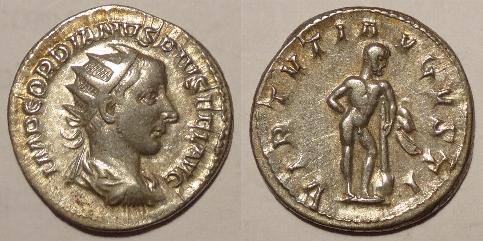
Gordian III (April 22, 238AD – February 11, 244AD)
This is a silver antoninianus minted by Gordian III about 241-2AD. The obverse has the radiate, draped and cuirassed bust right with his title IMP GORDIANVS PIVS FEL AVG. The reverse has Hercules standing right leaning on club set on rock holding a lion skin with the legend VIRTVTI AVGUSTI. The coin measures 18mm.
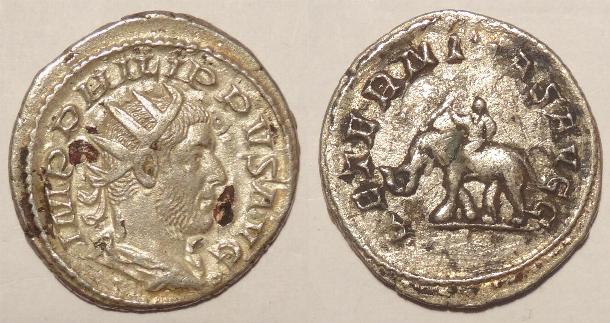
Philip I (February 244AD – September/October 249AD)
This is a silver antoninianus minted by Philip 1 (known as The Arab) around 247AD. The obverse has a radiate, draped and cuirassed bust facing right with the title IMP PHILIPPVS AVG. The reverse has an elephant walking to left guided by a driver with the legend AETERNITAS AVGG. The coin measures 21mm.
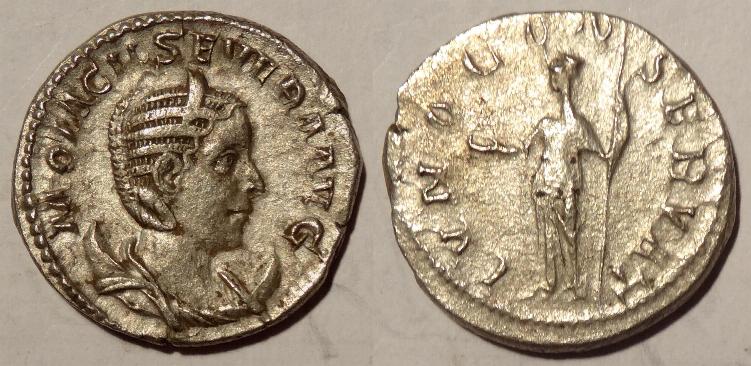
Marcia Otacilia Severa (wife of Philip I) 244-249AD
This is a silver antoninianus issued for Otacilia Severa around 244-9AD. The obverse has her diademed and draped bust resting on crescent to the right with her title M OTACIL SEVERA AVG. The reverse has Juno standing facing to the left holding a scepter and patera with the legend IVNO CONSERVAT. The coin measures 22mm.
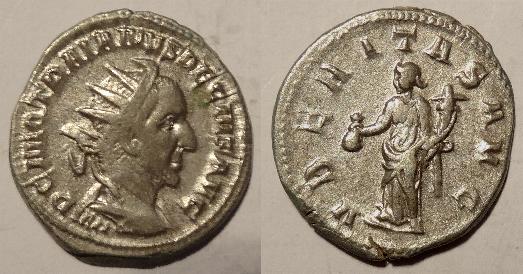
Trajan Decius (September/ October 249AD – June 251AD}
This is a silver antoninianus minted by Trajan Decius around 250AD. The obverse has a radiate head facing right with his title IMP C M Q TRAIANVS DECIVS AVG. The reverse has Uberitas standing left holding purse and cornucopiae with the legend VBERITAS AVG. The coin measures 20mm.
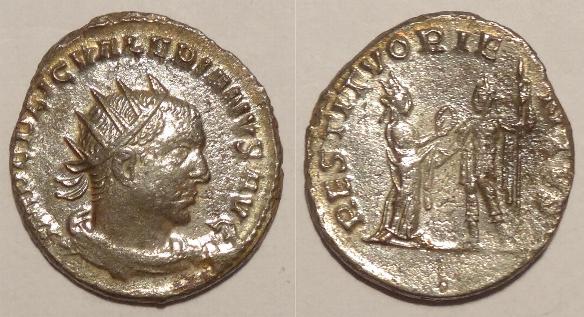
Valerian (October 253 AD – 260 AD)
This is a silver antoninianus minted by Valerian about The obverse has a radiate bust facing rightwith the title IMP C P LIC VALERIANVS AVG. The reverse has Orient standing presenting wreath to Valerian with the legend RESTITV ORIENTIS (this is an error since it is supposed to read RESTITVT ORIENTVS). The coin measures 20mm.
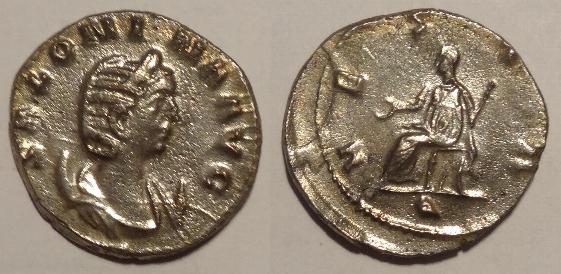
Salonina (Wife of Gallienus) (253-268AD)
This is a silvered billon antoninianus issued for Salonina around 260-268AD. The obverse has her diademed draped bust facing right on a crescent with her title SALONINA AVG. The reverse has Vesta seated facing left holding a patera and scepter with Q in the exergue and the legend VESTA. The coin measures 21mm.
Claudius Gothicus (September 268AD – January 270AD)
This is a silvered billon antoninianus issued by Claudius Gothicus around 268-270AD. It was minted in Antioch, in today's Syria. The obverse has the radiate bust facing left with his title IMP C CLAVDIVS AVG. The reverse has Neptune stanfing holding a dolphin in his left hand and trident in his right hand. There is a pellet mintmark for Antioch in the exergue with the legend NEPTVN AVG. The coin measures 19mm.
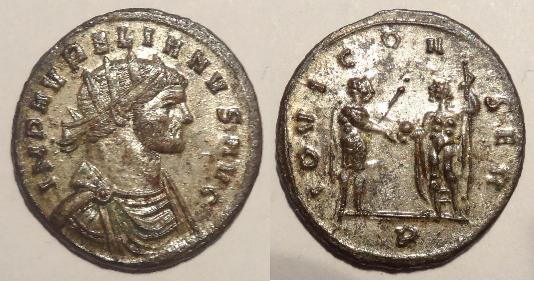
Aurelian (September(?) 270AD – September 275AD)
This is a silvered billon antoninianus issued by Aurelian around 270AD. The obverse features a radiate bust facing right with his title IMP AVRELIANVS AVG. The reverse has Jupiter passing a globe to Aurelian with the legend IOVI CONSERV. The mintmark P is in the exergue. The coin measures 23mm.
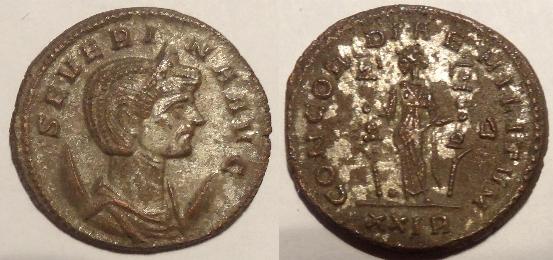
Ulpia Severina (wife of Aurelian, entitled Augusta in 274AD. Ruled in her own right in 275AD}
This is a silvered billon antoninianus issued for Severina around 274AD. The obverse has her bust facing right with corn cobs bottom left and right of portrait with her title SEVERINA AVG. The reverse has Concord standing between two military standards with Greek letter Δ to the right and XXIR in exergue with the legend CONCORDIAE MILITVM. The coin measures 21mm.
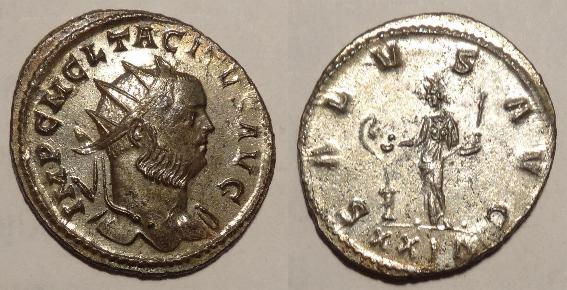
Tacitus (September 25, 275AD – June 276AD)
This is a silvered billon antoninianus issued by Tacitus around 275AD. The obverse has his radiate cuirassed bust facing right with his title IMP C M CL TACTVS AVG. The reverse has Salus standing left, holding a scepter, feeding a serpent rising from an altar with XXID in exergue and the legend SALVS AVG. The coin measures 21mm.
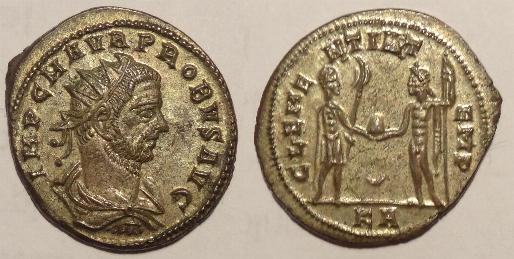
Probus (September? 276AD – September/ October 282AD)
This is a silvered billon antoninianus issued by Probus from the Tripolis mint in today's Lebanon. The obverse is the radiate bust facing right with his title IMP CM AVR PROBUS AVG. The reverse has the emperor standing right, holding an eagle-tipped scepter, receiving globe from Jupiter holding a scepter. There is a crescent in lower center with the mintmark KA in the exergue and the legend CLEMENTIA TEMP. The coin measures 21mm.
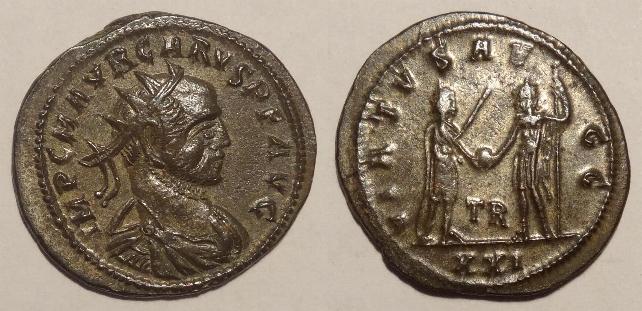
Carus (September/ October 282AD – late July/ early August 283AD)
This is a silvered billon antoninianus issued by Carus from the Tripolis mint in today's Lebanon. The obverse has a radiate, draped, cuirassed bust facing right with his title IMP C M AVR CARVS P F AVG. The reverse has the emperor standing right, holding an eagle-tipped scepter, receiving globe from Jupiter, standing left, holding scepter. The mintmark TR is in lower center, XXI in exergue, and the legend VIRTVS AVGG. The coin measures 21mm.
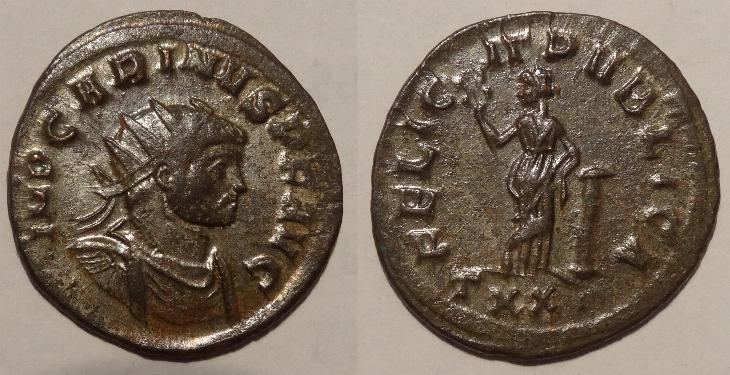
Carinus (Late July/early August 283AD – 285AD)
This is a silvered billon antoninianus issued by Carinus minted in Ticinum, today's Pavia, Italy. The obverse has the radiate, draped and cuirassed bust facing right with his title IMP CARINVS P F AVG. The reverse has Felicitas standing left, holding caduceus, leaning her left elbow on a column, withthe mintmark TXXI is in the exergue with the title FELICIT PVBLICA. The coin measures 22mm.
Tetrarchy and Constantinian Dynasty
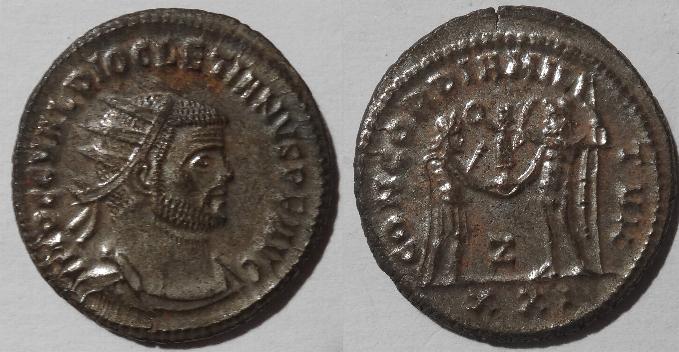
Diocletian (November 20, 285AD – May 1, 305AD)
This is a silvered billon antoninianus issued by Diocletian minted in Antioch in today's Syria. The obverse has his radiate draped bust right with his title IMP C C VAL DIOCLETIANVS P F AVG. The reverse has Diocletian receiving Victory on globe from Jupiter with Z in the lower center, XXI in the exergue, with the legend CONCORDIA MIL-ITVM. The coin measures 22mm.
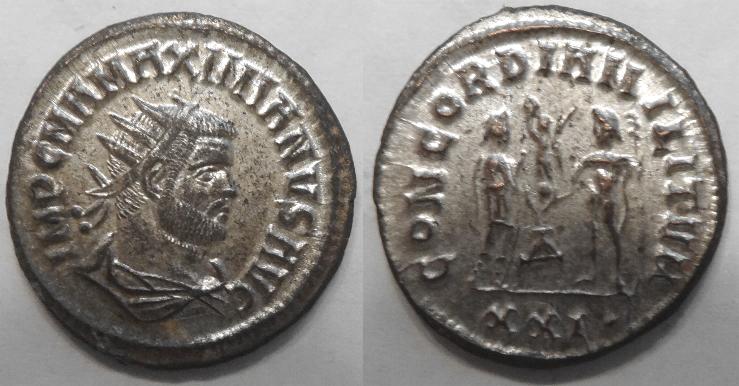
Maximianus (April 1, 286AD – May 1, 305AD)
This is a silvered billon antoninianus issued by Maximianus from the Heraclea mint in today's Turkey. The obverse has the radiate, draped or cuirassed bust facing right with his title IMP C M A MAXIMIANVS AVG. The reverse has Jupiter presenting Victory on a globe to Maximianus, with officina D between the figures and XXI• in exergue with the legend CONCORDIA MILITVM. The coin measures 21mm.
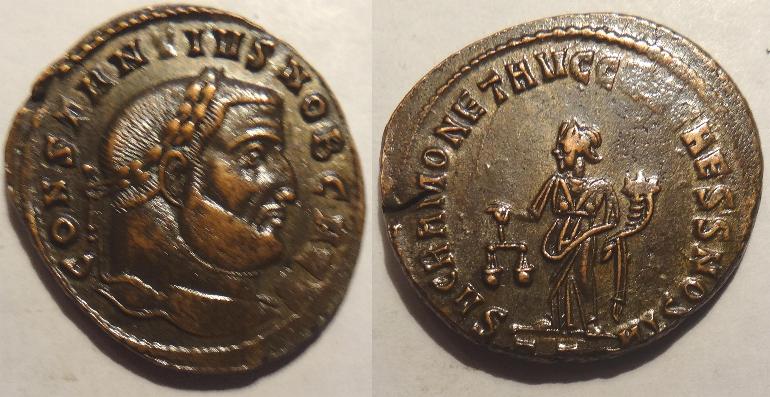
Constantius I Chlorus (May 1, 305AD – July 25, 306AD}
This is bronze follis struck under Constantius I in 300-1AD. The obverse has the laureate head facing right with the title CONSTANTIVS NOB CAES. The reverse has Moneta standing left holding scales and cornucopia with a club in the exergue with the legend SACRA MONET AVGG ET CAESS NOSTR. This coin measures 27mm.
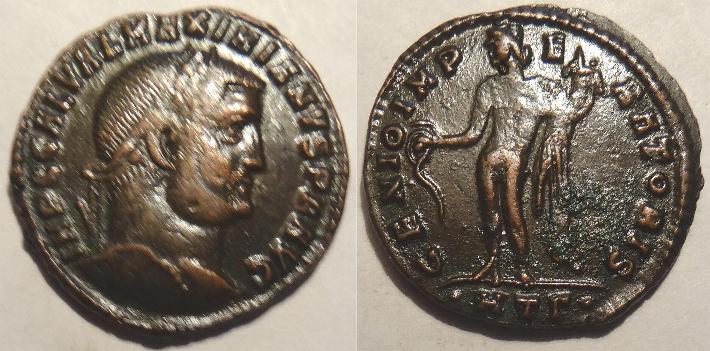
Galerius (May 1, 305AD – May 311AD)
This is bronze follis struck under Galerius in 308-9AD. It was minted in Heraclea in today's Turkey. The obverse has a laureate facing head right with the title IMP C GAL VAL MAXIMIANVS P F AVG. The reverse has Genius standing left pouring liquid from a patera and holding cornucopia with the mintmark dot HTG dot in the exergue and the legend GENIO IMPERATORIS. The coin measures 25mm.
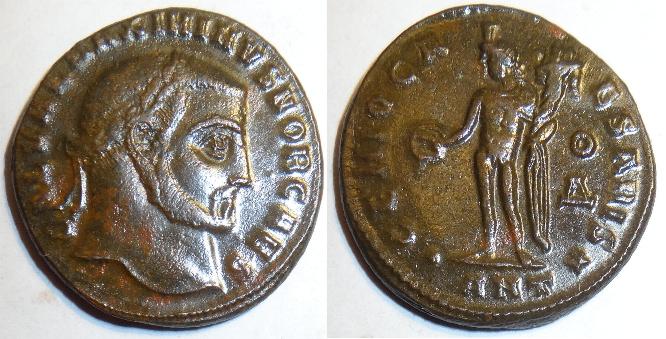
Maximinus II (May 1, 311AD – July/August 313AD)
This is a bronze follis minted by Maximinus II in 208AD at the Antiochia mint in today's Turkey. The obverse features a laureate head facing right with his title GAL VAL MAXIMINVS NOB CAES GENIO CAESARIS. The reverse has Genius standing left, modius on head, naked except for chlamys over left shoulder (falls low), holding patera from which liquid flows and a cornucopia. The right field has O and Δ ant the mintmark dot ANT star? in the exergue. The coin measures 24mm.
Constans I (May 22, 337AD – 350AD)
This coin is an AE3 minted in Trier in today's Germany around 337-8AD. The obverse has a pearl diademed, draped, cuirassed bust facing right with his title CONSTAN-S PF AVG. The reverse has two Victories facing each other, each holding a wreath and palm with D in lower center. The mintmark TRP is in exergue with the legend VICTORIAE DD AVGGQ NN. The coin measures 15mm.
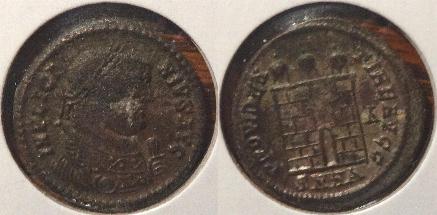
Licinius I (November 11, 308AD – September 18, 324AD)
This is a bronze AE4 minted under Licinius I from 318-320AD. The obverse has a laureate bust facing right, wearing imperial mantle, holding globe, scepter and mappa (white napkin dropped by an emperor as a starting signal at the Circus) with his title IMP LICI-NIVS AVG. The reverse has a campgate with three turrets, no door, the Greek letter L in right field with the mintmark SMH and officina letter (A) in the exergue with the legend PROVIDENTIAE AVGG. The coin measures 19mm.
Licinius II (Caesar 317-324AD)
This is a bronze AE3 minted in Alexandria Egypt in 317AD. The obverse has a helmeted cuirassed bust facing left holding spear and shield with the title D N VAL LICIN LICINIVS NOB C. The reverse has Jupiter standing left, between eagle and captive, holding Victory on globe and scepter, X/IIG (=12.5 denarii) to right, and mintmark SMALB in exergue and the legend IOVI CONSERVATORI. The coin measures 20mm.
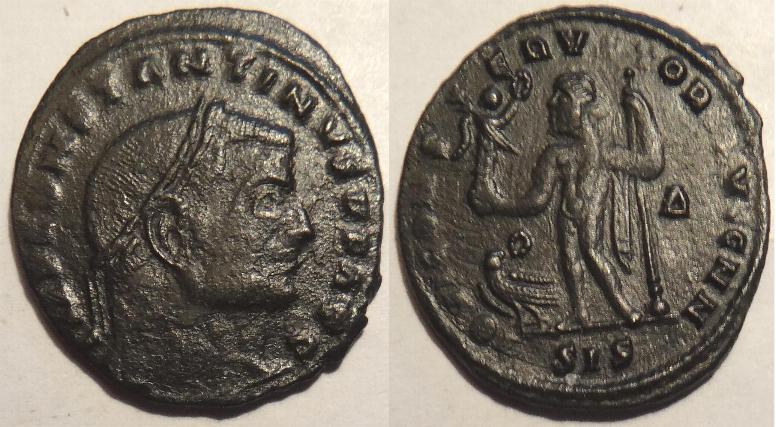
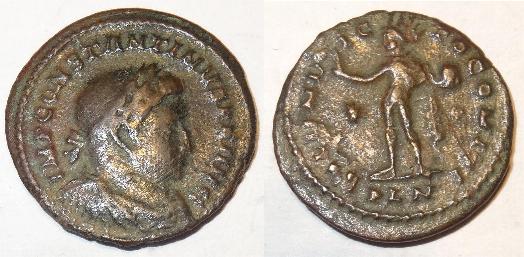
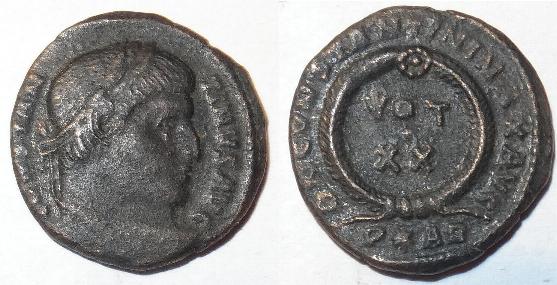
Constantine I (25 July 306AD – May 22, 337AD)
These eight bronze coins were issed by Constantine the First.
The top six are portrait coins atruck at various mints throughout the Roman Empire:
-
The top left one is from Siscia (in today's Croatia) - The obverse has a laureate head facing right with the title IMP CONSTANTINVS P F AVG. The reverse has Jupiter standing facing with head left, chlamys hanging from left shoulder, holding Victory on globe and leaning on scepter, eagle left, officina letter E to right, with the mintmark SIS in the exergue and the legend IOVI CONSERVATORI AVGG NN. The coin measures 22mm.
-
The top right one is from London minted in 310AD. The obverse has a laureate and cuirassed bust facing right with his title IMP CONSTANTINVS P F AVG. The reverse has Sol standing left, chlamys falling from left shoulder, holding globe, right hand raised, mintmark PLN in exerge and the legend SOLI INVICTO COMITI. The coin measures 22mm.
-
The second left one is from Arles (France) in 322-3AD. The obverse has the laureate head facing right with the title CONSTANTINVS AVG right. The reverse has VOT XX in wreath, mintmark P* AR in exerge encircled by the legend / DN CONSTANTINI MAX AVG. The coin measures 18mm.
-
The second right one is from Antiochia (in today's Turkey) struck in 330-5AD. The obverse has a rosette-diademed, draped and cuirassed bust facing right with the title CONSTANTINVS MAX AVG. The reverse has two helmeted soldiers standing facing one another, with spears and shields and standards between, mintmark SMANA in the exergue and the legend GLORIA EXERCITVS. The coin measures 16mm..
-
The third left one is from Hercelea (in today's Turkey) minted 330-5AD. The obverse has a rosette-diademed, draped, cuirassed bust facing right with the title CONSTANTINVS MAX AVG. The reverse has two soldiers holding spears and shields with two standards between them with the mintmark SMHB in the exergue with the legend GLORIA EXERCITVS. The coin measures 17mm.
-
The third right one is from Cyzicus (in today's Turkey). The obverse has a diademed cuirassed bust facing right with the title CONSTANTINVS MAX AVG. The reverse has two soldiers standing front, heads turned inward at two standards between them, each holding spear and shield, mintmark SMKS in the exergue with the legend GLORIA EXERCITVS. The coin measures 15mm.
The final two are different in that they are not the usual potrait coins but commemorative in nature honoring Rome and the founding of the new capital Constantinopolis:
-
The bottom left one's obverse has a helmeted bust of Roma facing left with the legend VRBS ROMA. The reverse has two helmeted soldiers facing each holding inverted spear and rests on a shield with the mintmark CONSA and the legend GLORIA EXERCTVS. It was minted in Constantinoplis about 340AD and measures 14mm.
-
The bottom right one has a helmeted bust facing left, wearing imperial mantle and holding scepter with the legend CONSTANTINOPOLIS. The reverse has Victory standing facing left., foot on prow, holding a sceptre and leaning on a shield. The mintmark MKNI is in the exergue and the legend reads GLORIA EXERCTVS. The coin measures 21mm.
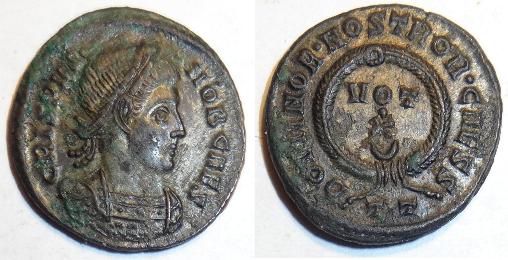
Crispus (Caesar 317-326AD.)
This bronze coin was minted in 322-5AD at Ticinum, today's Pavia, Italy. The obverse has a laureate, cuirassed bust facing right with his title CRISPVS NOB CAES . The reverse has VOT 9dot X and a crescent within a wreath wit the legend DOMINOR NOSTROR CAESS and mintmark TT in the exergue. This coin measures 18mm.
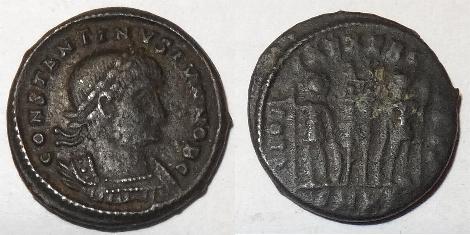
Constantine II (May 22, 337AD – 340AD)
This bronze coin was minted in Cyzicus in today's Turkey around 330-5AD. The obverse has a laureate and cuirassed bust facing right with the title CONSTANTINVS IVN NOB C. The reverse has two soldiers standing with standards wit the legend GLORIA EXERCITVS and with the mintmatrk SMKI in the exergue. The coin maeasures 18mm.
Julian II (February 360AD – June 26, 363AD)
This bronze coin was minted by Julian II. The obverse has a bearded diademed bust facing right with the title FL CL IVLIANVS P F AVG. The reverse has VOT V MULT X within a wreath with an unreadable mintmark below. The coin measures 22mm.
Valentinian Dynasty
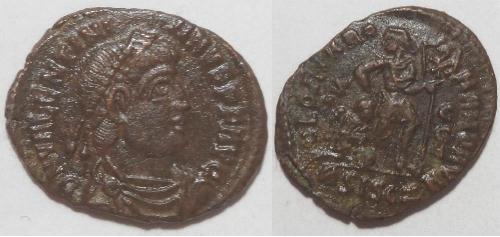
Valentinian I (February 26, 364AD – November 17, 375AD)
This bronze coin was minted by Valentinan I. The obverse has a laureate bust facing right with the title D N VALENTINIAVS PF AVG. The reverse has the emperor in military dress, advancing right, head left, holding labarum, dragging a captive behind him. There is in the left field an S over dot and in the right field a C over symbol 4 with the mintmark BSISCZ in the exergue. The coin measures 22mm.
Theodosian Dynasty
Theodosius I (January 1, 379AD – January 17, 39 AD)
This bronze coin was minted by Theodosius in 393-395AD. The obverse bas a laureated head facingg right with the title DN THEODOSIUS P F AVG. The reverse has Theodosius standing to the right. holding the labarum and globe with the mintmark SMKA in the exergue and the legend GLORIA ROMANORVM. The coin measures 22mm.
ROMAN PROVINCIAL/GREEK IMPERIAL
Roman Provincial coins are coins that were especially minted for use in territories out side of Italy proper. Many of the coins for areas formerly Greek have Greek legends, some even with Greek words in the Latin alphabet, with busts of the Roman emperor, these are usually referred to as Greek Imperial coins.
These coins will be presented in alphabetical order.
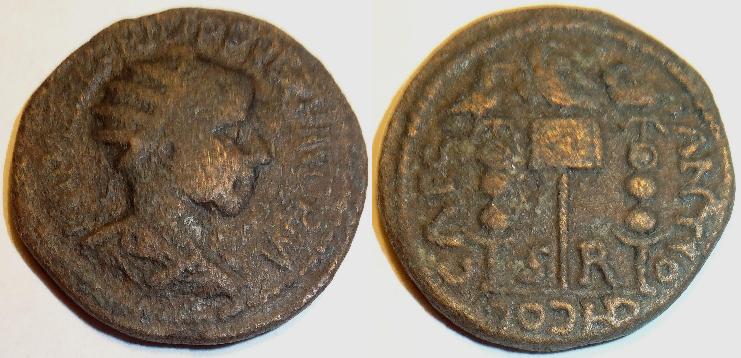
ANTIOCH - Pisidia
This large bronze coin was minted under Philip II in 244-249AD. Yhe obverse has his radiate draped and cuirassed bust facing right with hisd title IMP M IVL PHILIPPVS AVG, The reverse has the vexillum between two standards, all surmounted by eagles, S-R to left and right of its base with the legend CAES ANTI OCL IC. The coin measures 27mm.
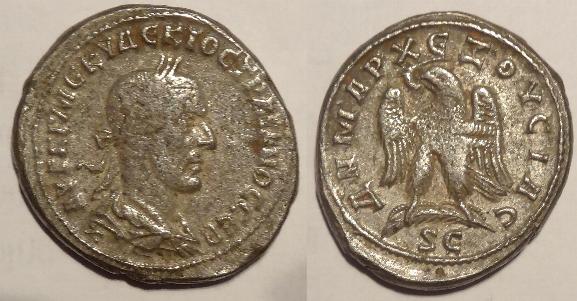
ANTIOCH - Syria
This is a base silver coin minted by Trajan Decius around 250AD. The obverse has his laureate head facing right with his title AVT K G ME KY DEKIOC TPAIANOC CEB. The reverse has an eagle standimg facing right on a [palm branch with wreath in beak with the legend DHMAPX EXOYCIAC with SC in the exergue. The coin measures 27mm.
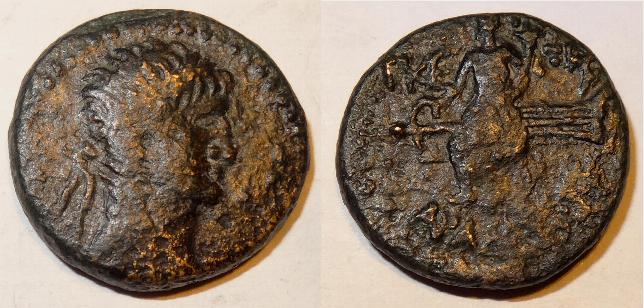
ARADUS - Phoenicia
This is a bronze coin minted for Nero in 66AD. The obverse has a laureate head of Nero facing right. The reverse has Tyche seated left on rudder holding cornucopia with the legend APAΔIWN and TKE for the date 235 in the local calendar. The coin measures 22mm.
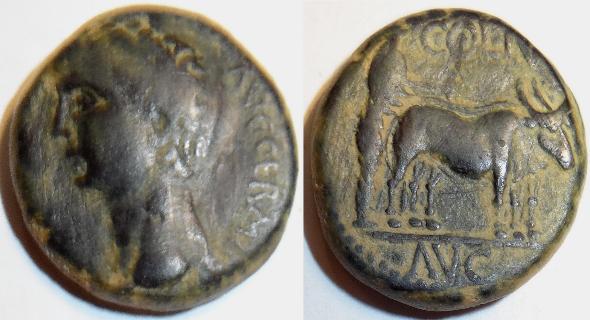
BERYTUS - Phoenicia
This bronze coin was minted in 41-54AD. The obverse has Claudius' head facing left with the title TI CLAVD CAESAR AVG GERM IMP (first part is off the planchet). The reverse has a colonist plowing to the right with yoke of oxen with the legend COL IVL AVG. The coins measures 22mm. This is today's Beirut Lebanon and was then named Colonia Iulia Augusta Felix Berytus.
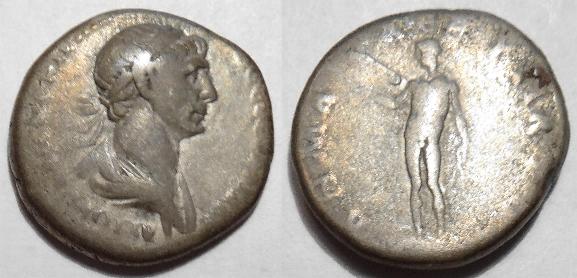
CAPPODOCIA - Caesarea
This is a silver didrachm issued by Trajan about 112-117AD. The obverse has a laureate draped bust facing right with his title AYTOKP KAIC NEP TPAIANO CEB GEPM DAK. The reverse has Apollo standing left, holding olive branch and a bow and arrow with the legend ΔΗΜΑΡΧ ΕΞ ΥΠΑΤΟ. The coin measures 21mm.
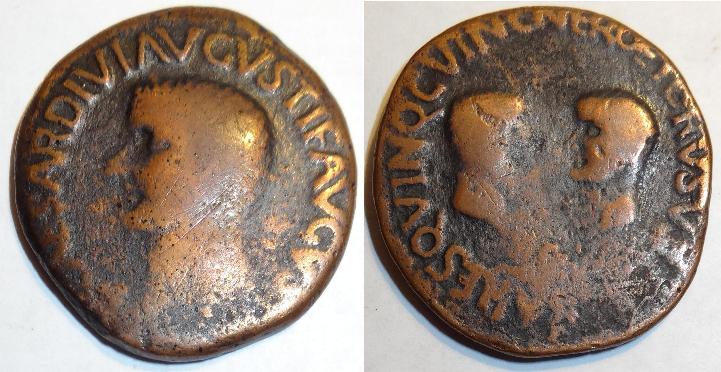
CARTHAGO NOVA - Iberia
This bronze Roman provinicial coin was minted in Carthago Nova (today's Cartegena, Spain) in 14-27AD. The obverse has a bare head of Tiberius facing left with his title TI CAESAR DIVI AVGVSTI F AVGVSTVS. The reverse has confronted bare-headed and draped busts of Nero and Drusus with the legend NERO ET DRVSVS CAESARES QVINQ C V I N C starting at the top running clockwise. The coin measures 27mm.
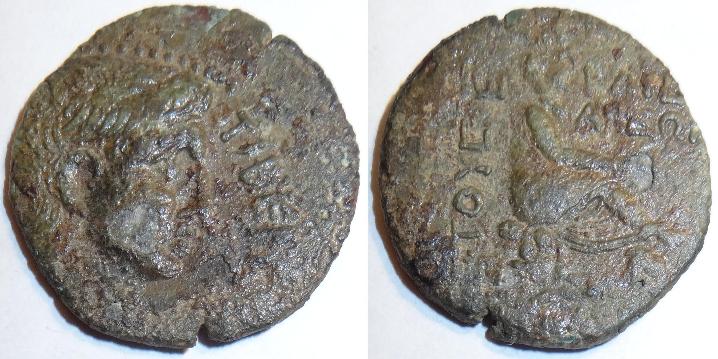
CILICIA - Anazarbos
This is a bronze coin minted for Tiberius around 45AD. The obverse has his laureate head facing right with his title TIBEPIOS KLAUDIOS KAISAP TIBE (most off planchet). The reverse has Tyche seated right on apile of rocks, river god swimming below with the legend / ETOYC E KAIC-APEW. The coin measures 23mm.
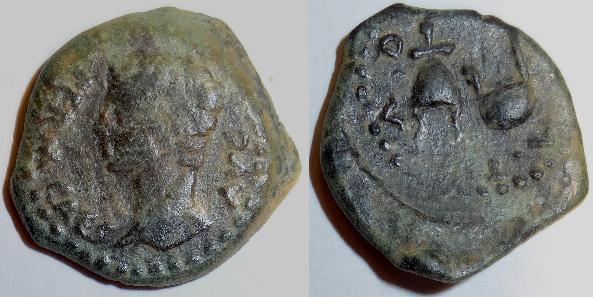
COLONIA PATRICIA - Iberia
This bronze coin was minted in 19-2 BC by Augustus. The obverse has his bare head facing left with his title PERM CAES AVG. The reverse has priestly implements, an apex and a simpulum with the legend COLONIA PATRICIA. The coin measures 18mm. This is today's Corduba, Spain.
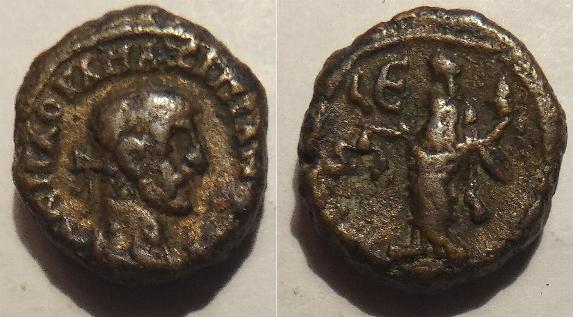
EGYPT - Alexandria
This billon Greek Imperial tetradrachm was minted in 289/290 AD in Alexandria. The obverse has a laureate head of Maximianus facing right with the title in Greek A K MA OVA MAΞIMIANOC CEB. The reverse has Dikaiosyne standing facing, head left, wearing chiton (a sewn garment) and peplos (a garment securede by a fibula), scales in right hand, a cornucopia in left with EL in top left field (Year 5). The coin measures 16mm.
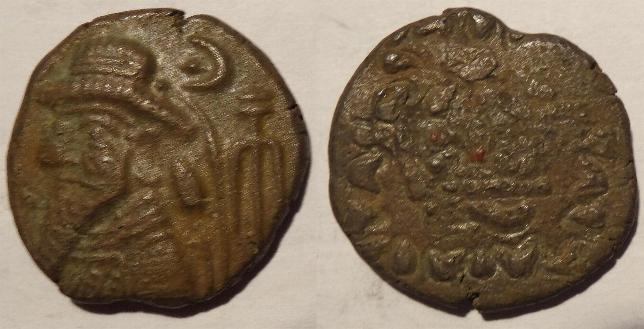
Elymais
This is a billon tetradrachm minted in the late first or early 2nd century AD by Kamnaskires VI (?). The obverse has a diademed and draped bust facing left, with long beard and wide fringe of hair below diadem, a star within crescent above and an anchor below. The reverse has a blundered Greek legend. The coin measures 26mm. These people were known as Elamites and lived in the area of present day Kuwait, Iraq, and Iran.
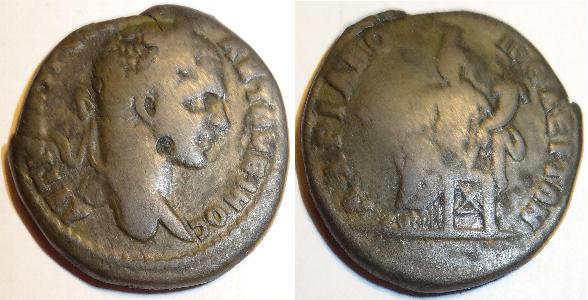
HADRIANOPOLIS - Thrace
This is a bronze coin minted by Caracalla in 198-217AD. The obverse has his laureate head facing right with his title AVT K M AVP CEP ANTWNEINOC. The reverse has Tyche standing left holding rudder and cornucopia.with the legend ADRIANOPOLEITWN. The coin measures 26mm.
IRIPPO - Iberia
This bronze coin was minted by Augustus around 30BC, The obverse has the bare head of Augustus (Octavian) facing right with the inscription IRIPPO. The reverse has has a female seated left holding pine cone and cornucopiae. The coin measures 25mm. Irippo was located near today's Sevilla, Spain.
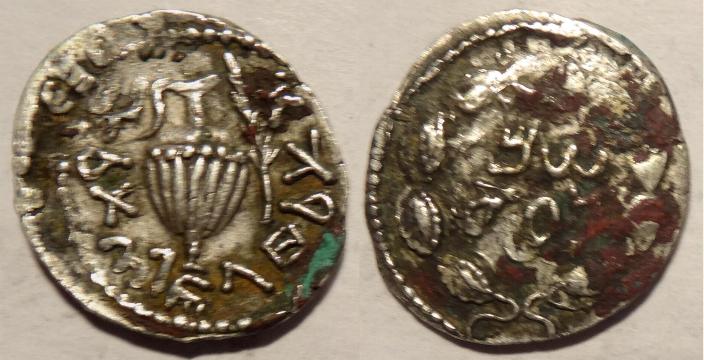
JUDEA
This is a silver denarius from Judaea issued during the Bar Kochba War, 134/135 AD. .The obverse has an inscription in paleo-Hebrew for Simon within wreath. The reverse has a jug with handle, palm frond to right with the paleo-Hebrew inscription around "for the freedom of Jerusalem". Traces of Latin inscriptions of the original Roman denarius that was overstruck are visible at the 10 o'clock position on the obverse. .The coin measures 19mm.
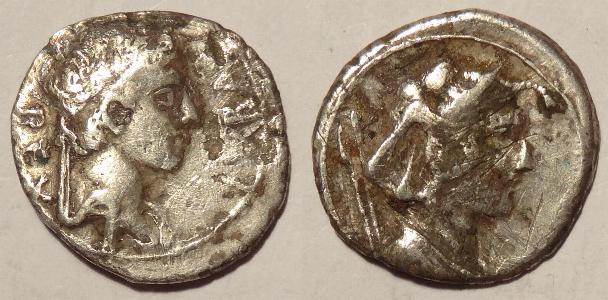
MAURETANIA
This silver denarius has King Juba's diademed bust facing right with his title REX IVBA. The reverse has head of Africa facing right with elephant skin and behind 2 spears. It was minted around 25BC-23AD, The coin measures 18mm.
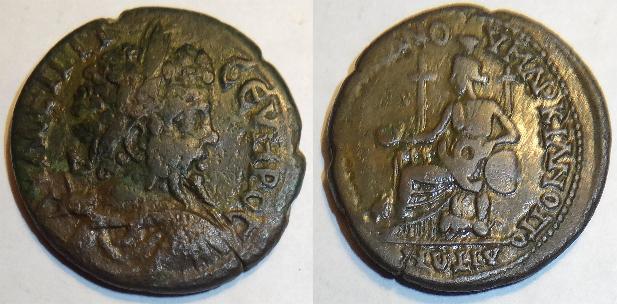
MOESIA INFERIOR - Marcianopolis
This is a bronze coin minted for Septimus Servus in 193-211AD. The obverse has a laureate, draped and cuirassed bust of Septimus Servus right with the title AV Λ CEΠT CEVHPOC. The reverse has Cybele seated left with patera, arm on drum, lion at side with the Greek legend for the magistrate Julius Faustinianus and the city's name VI FAVCTINIANOV MARKIANOPOLITWN .The coin measures 27mm.
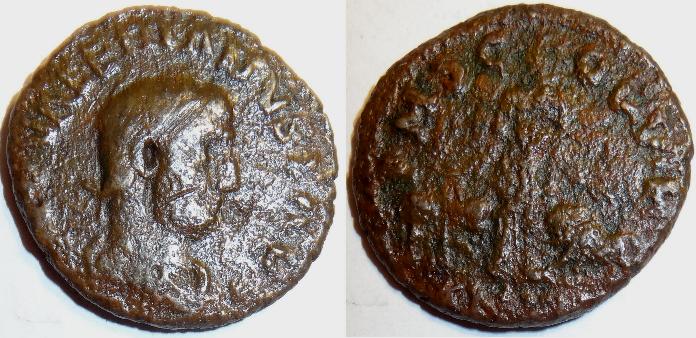
MOESIA SUPERIOR - Viminacium
This is a bronze coin minted for Gordian III in 243AD. The obverse has a laureated and cuiriassed. bust of Gordian III facing right with his title IMP GORDIANVS PIVS FEL AVG. The reverse has Moesia standing facing, head left, between bull and lion with the legend P M S COL VIM, and AN V in exergue. The coin measures 27mm.
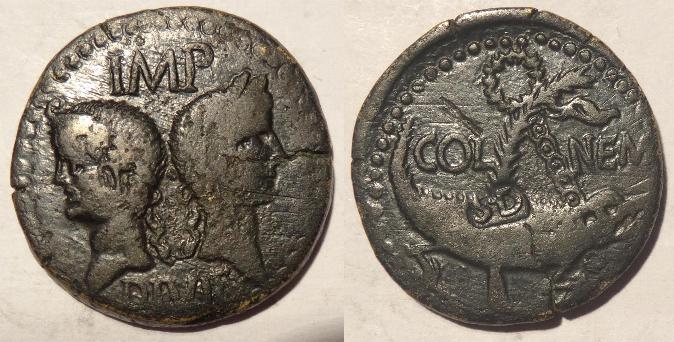
NEMAUSUS - Gaul
This bronze coin was minted in 9/8-3 BC. in Nemausus (present day Nimes France). The obverse features the heads of Agrippa to left and Augustus to right, back to back, that of Agrippa wearing combined rostral crown and laurel wreath, that of Augustus bare-headed with IMP above and DIVI below (off the planchet). The reverse has a palm-shoot behind a chained crocodile with a wreath at top with COL NEM. The coin has been counterstamped S-D, it is believed for use in Iberia. The coin measures 28mm.
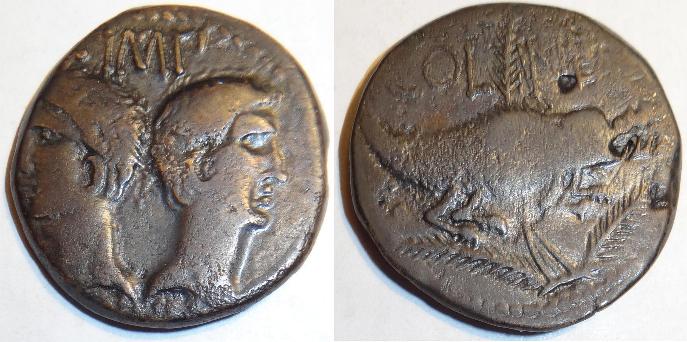
Another version of this bronze coin was minted in 27BC - 14AD in Nemausus (present day Nimes France). The obverse features the heads of Agrippa to left and Augustus to right, back to back, that of Agrippa wearing combined rostral crown and laurel wreath, that of Augustus bare-headed with IMP above and DIVI below (off the planchet). The reverse has a palm-shoot behind a chained crocodile; to left and right of palm-shoot, wreath with long ties with COL NEM. The coin measures 26mm.
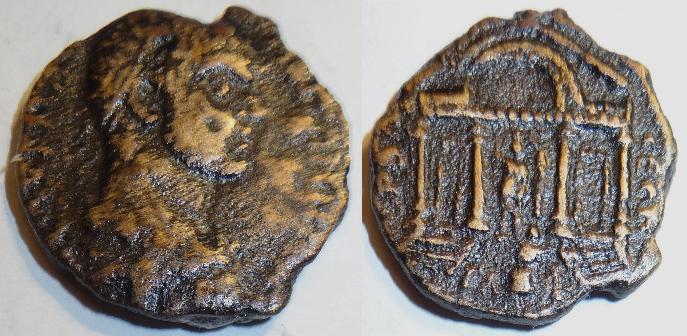
ORTHOSIA - Phoenicia
This is a bronze coin minted for Severus Alexander in 198-217AD. The obverse has his laureate bust facing right with his title ΑΥ Κ Μ ΑΥΡ ΑΛΕΕΞΑΝΔΡΟΣ ΚΑΙΣΑΡ. The reverse has a tetrastyle temple with pediment above central arch and doorways on sides with a statue of Astarte standing facing, holding scepter, a river god swimming right below, and the legend ORQWCIEWN on the sides. The coin measures 24mm.
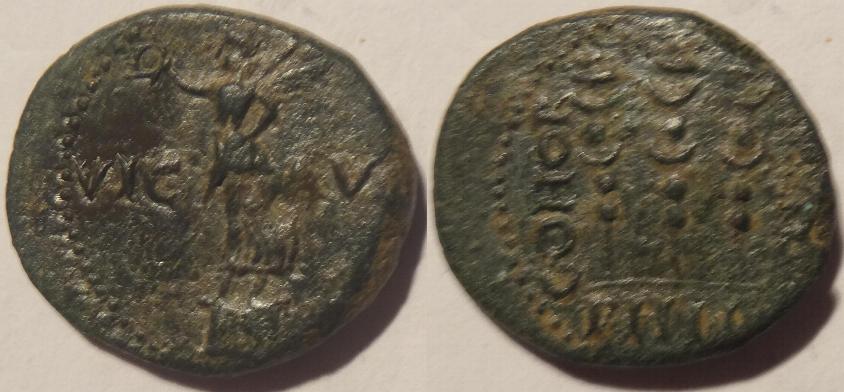
PHILIPPI - Macedonia
This is a bronze coin minted for Augustus around 27BC-14AD. The obverse has Nike standing left on globe holding wreath and palm with the legend VIC AVG. The reverse has three military standards with the legend COHOR PRAE PHIL.The coin measures 19mm.
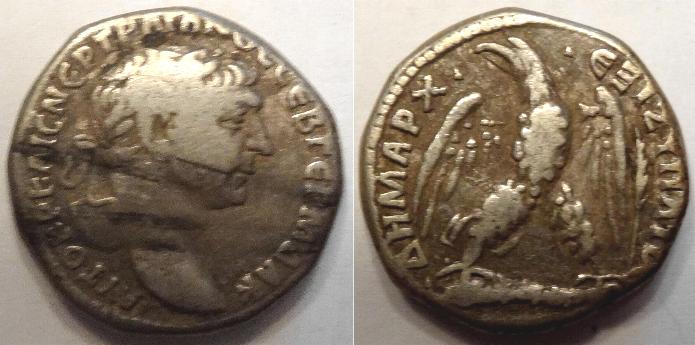
TYRE - Phoenicia
This is a base silver tetradrachm minted by Trajan in 112-3AD. The obverse has his laureate head facing right with his title AYTOKP KAIC NEP TPAIANOC CEB GERM DAK. The reverse has an eagle standing on club, head left, palm branch to the right with the legend DHMARC EX IZ UPAT. The coin measures 22mm.
free counters